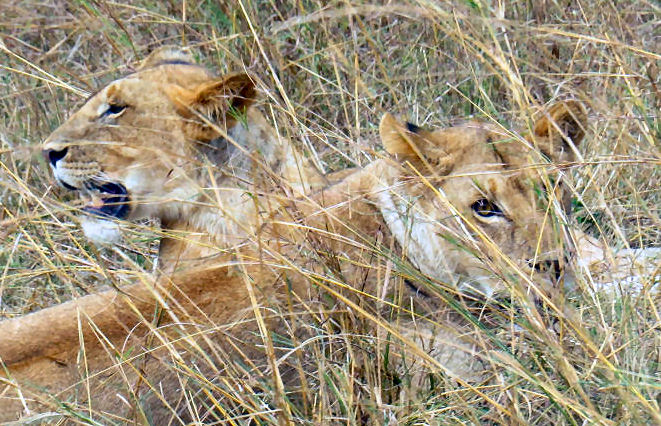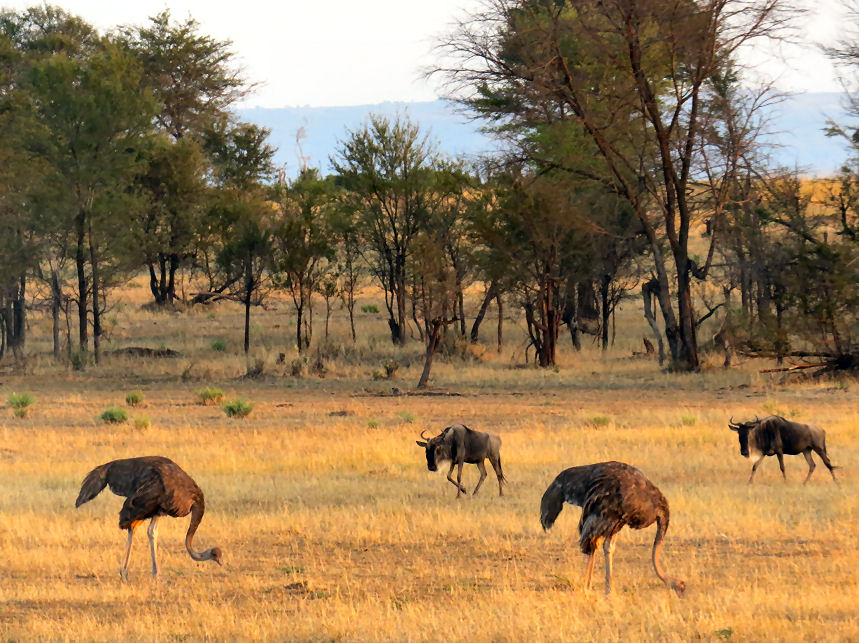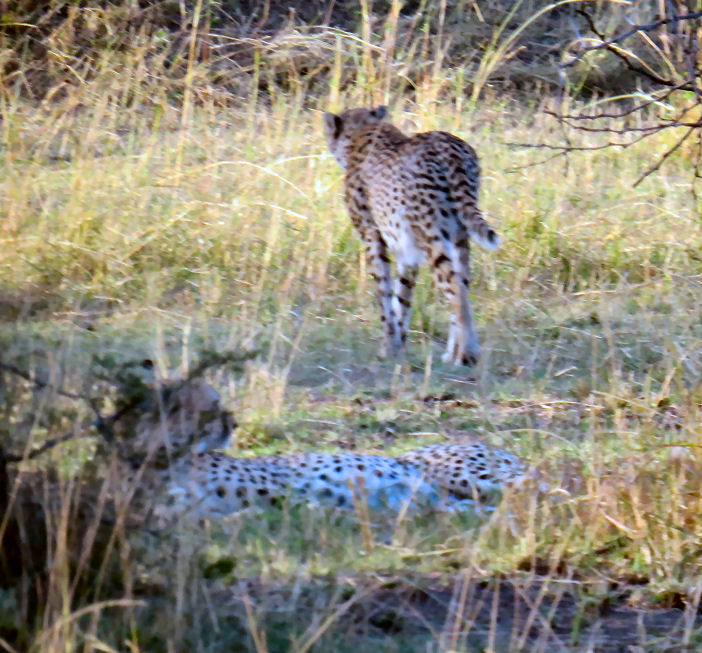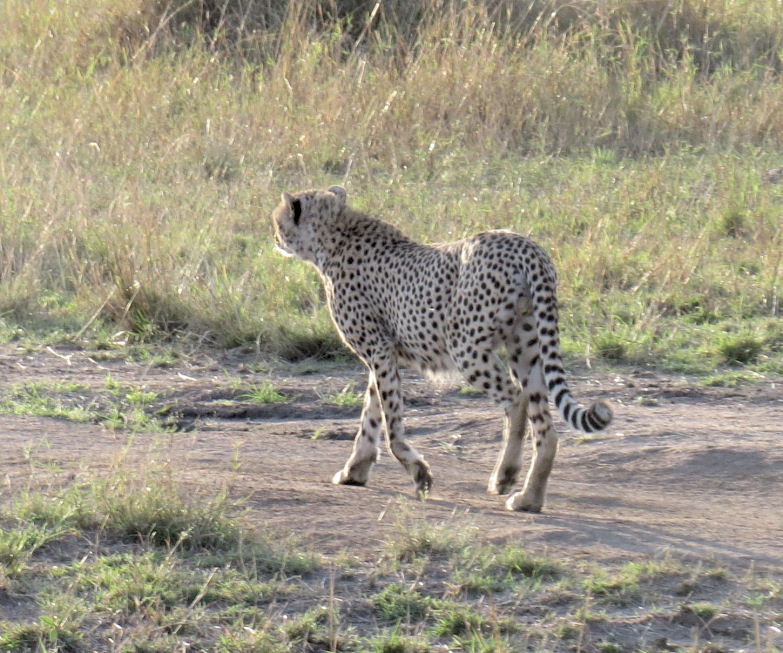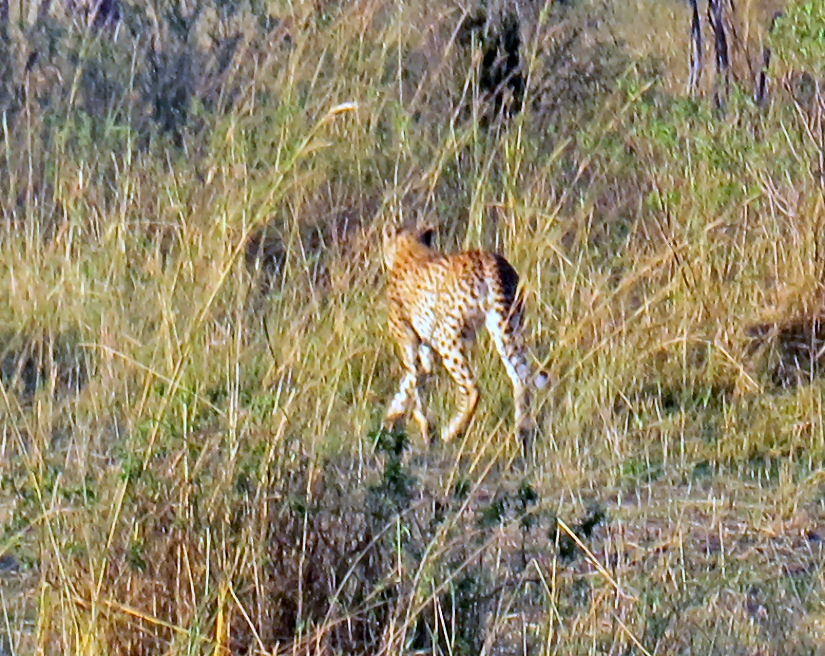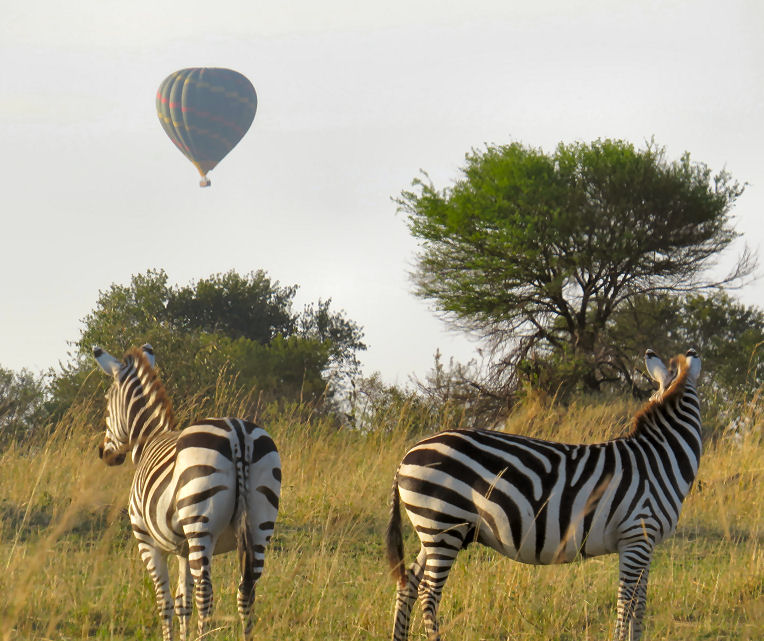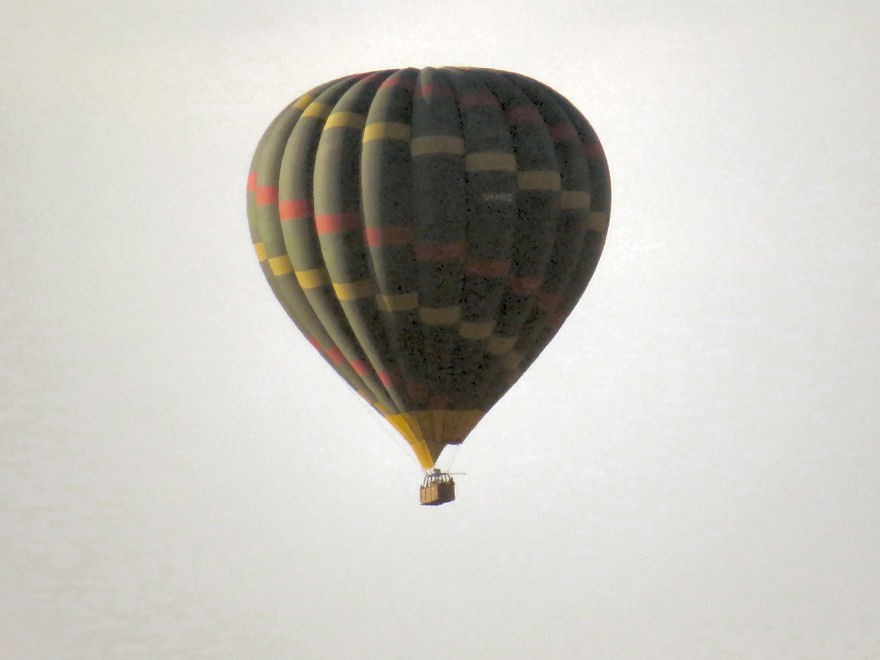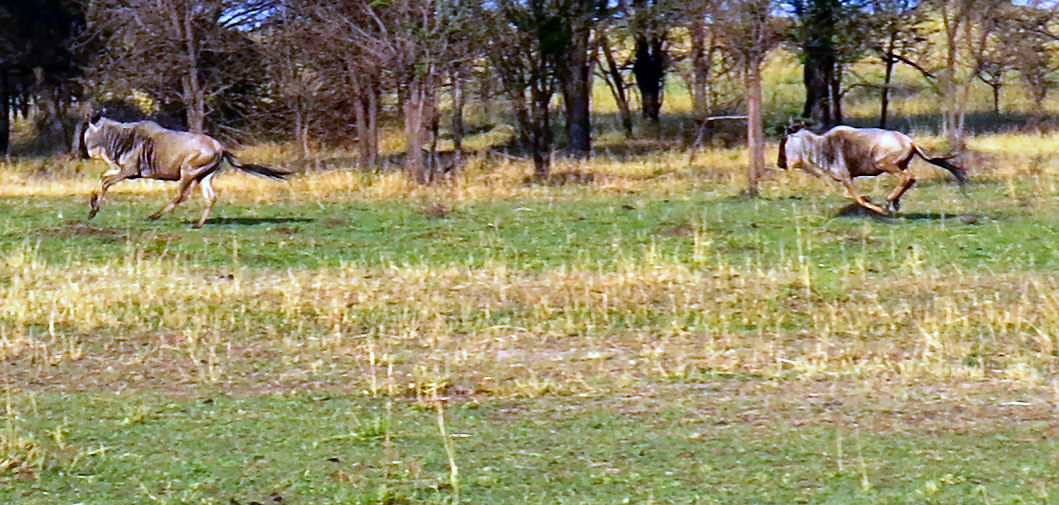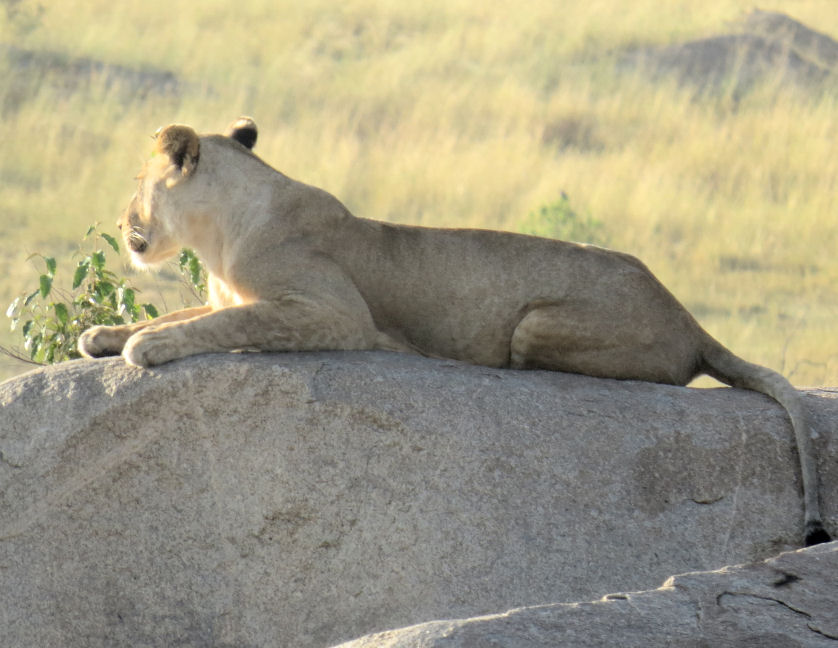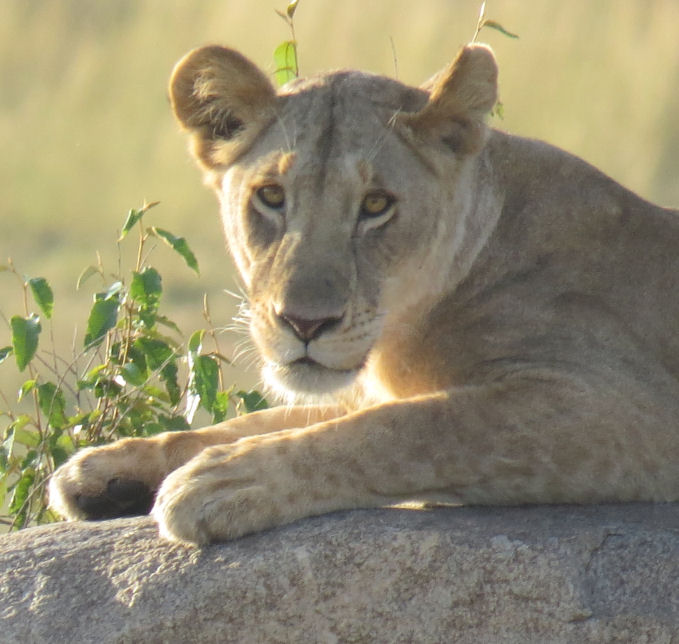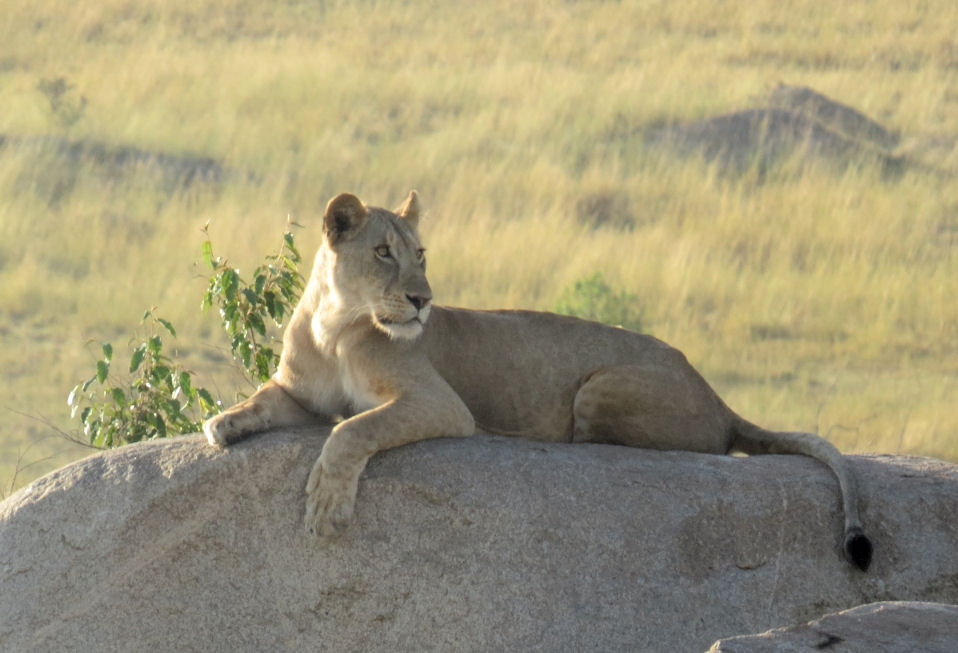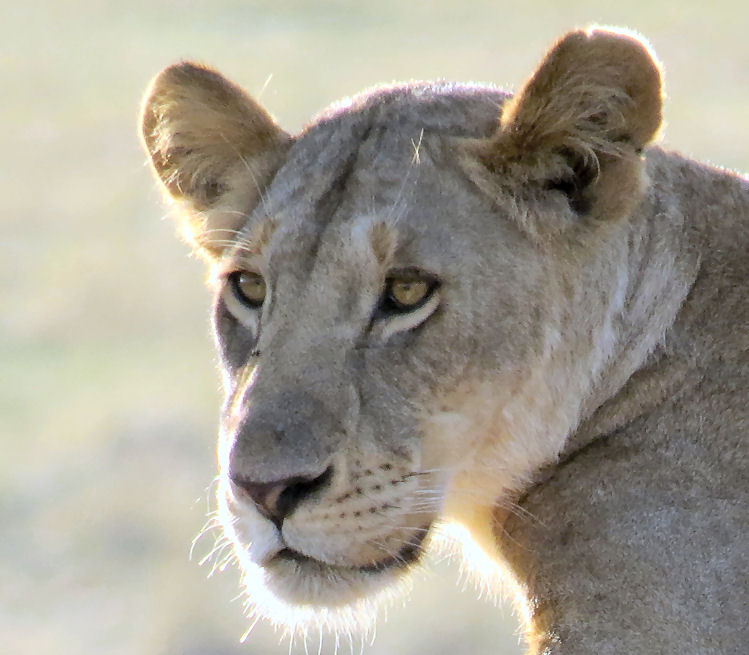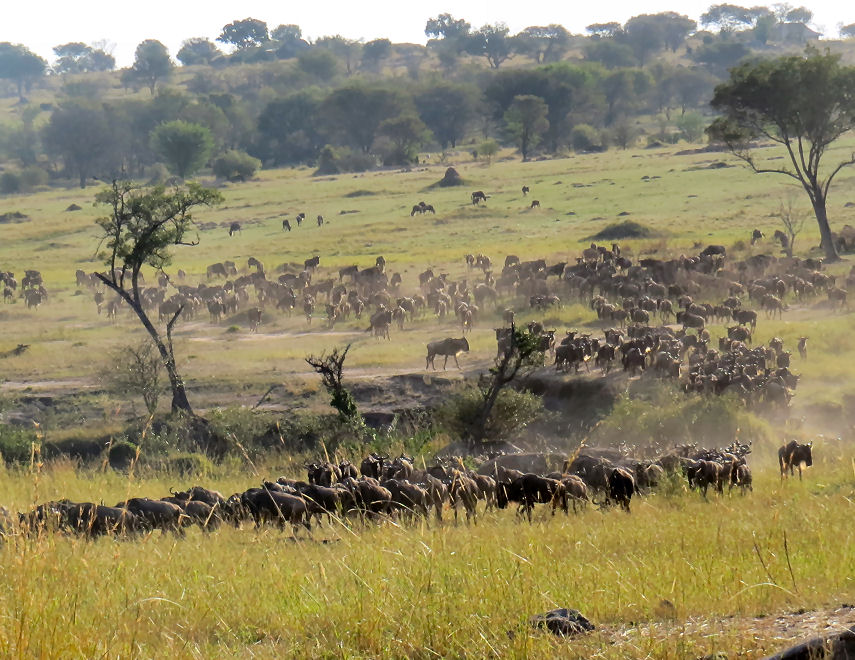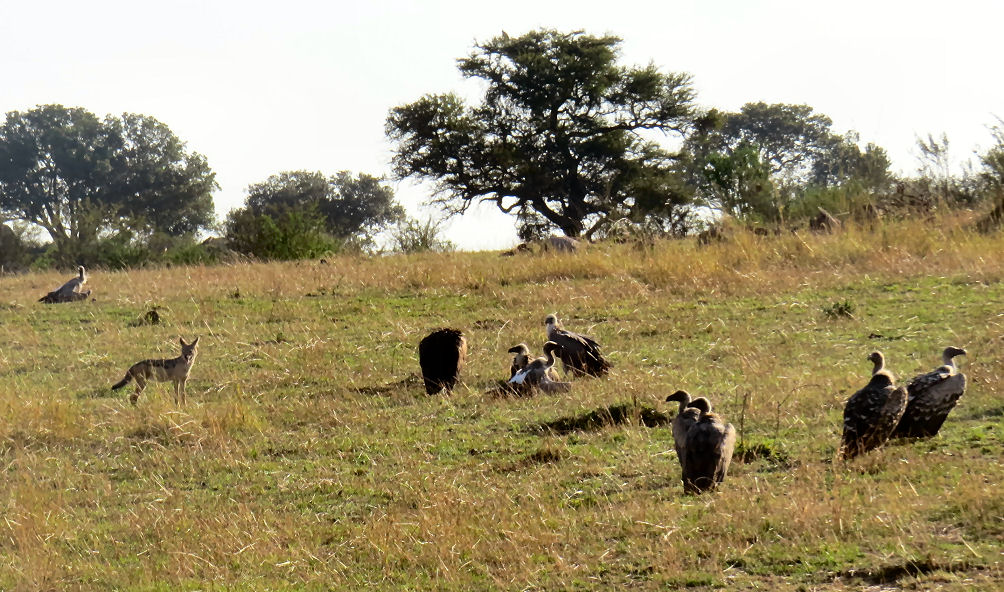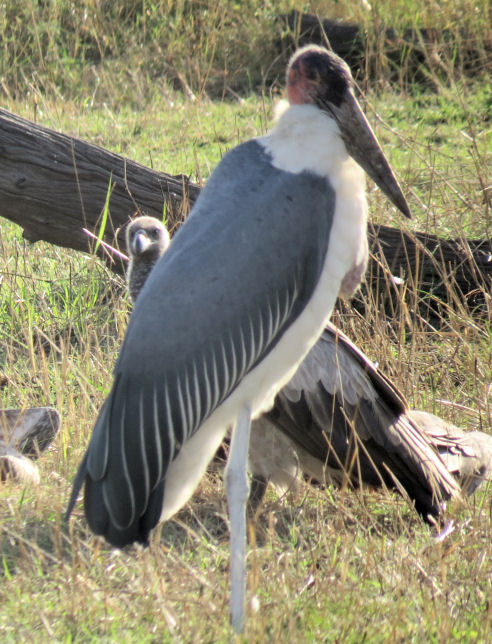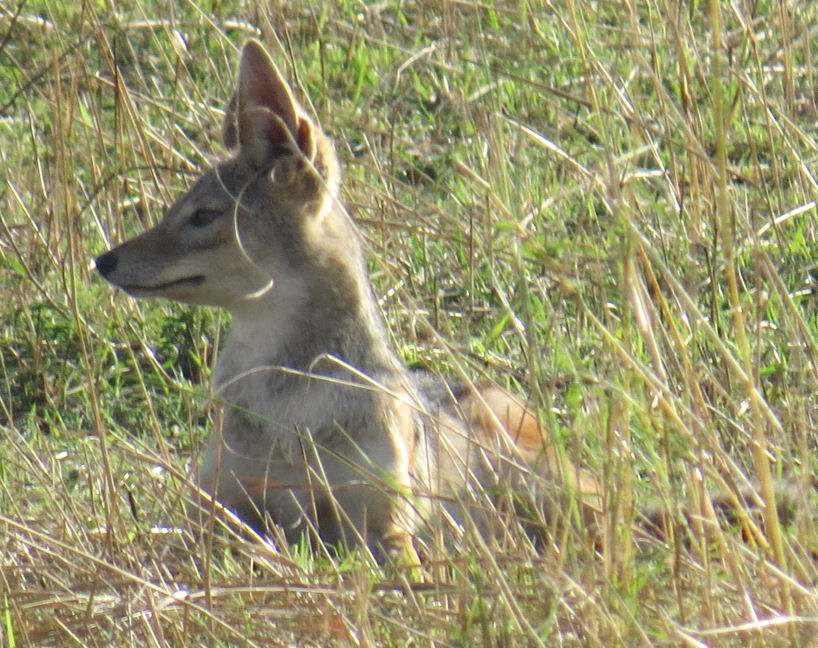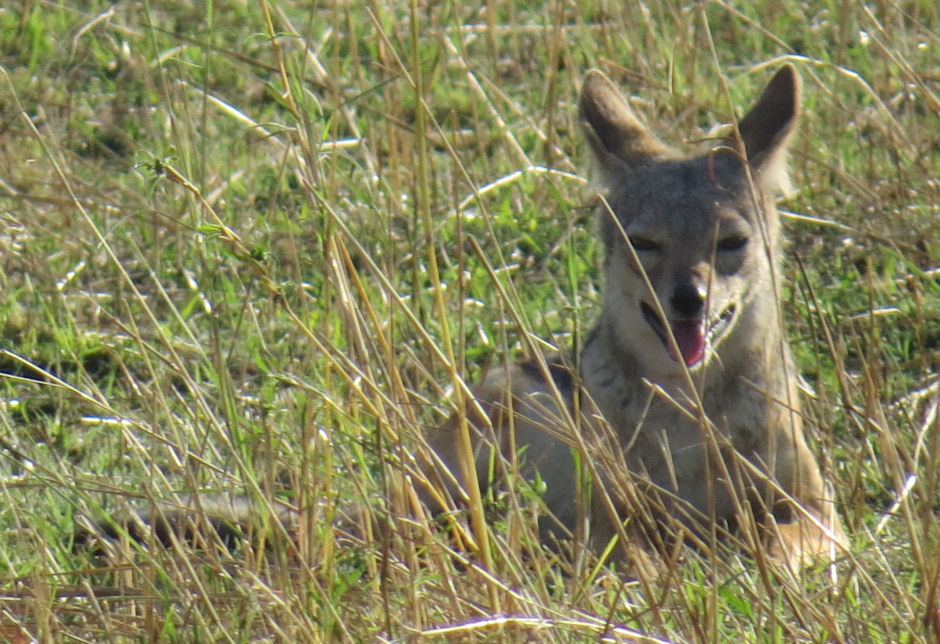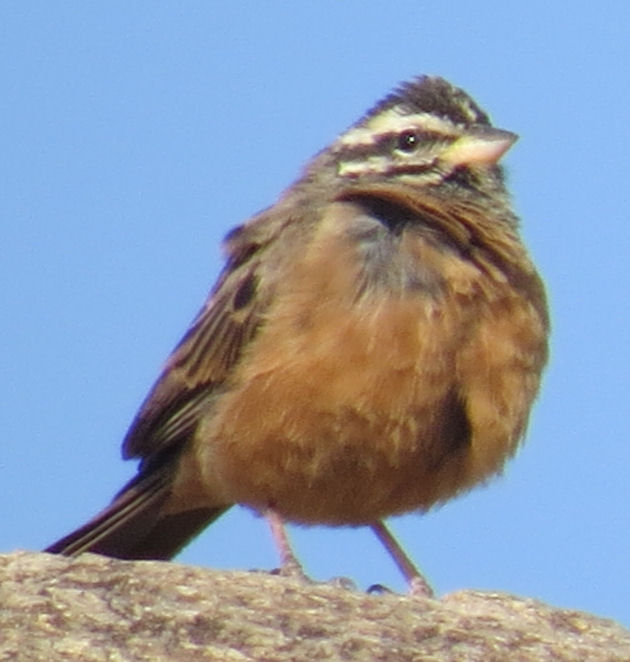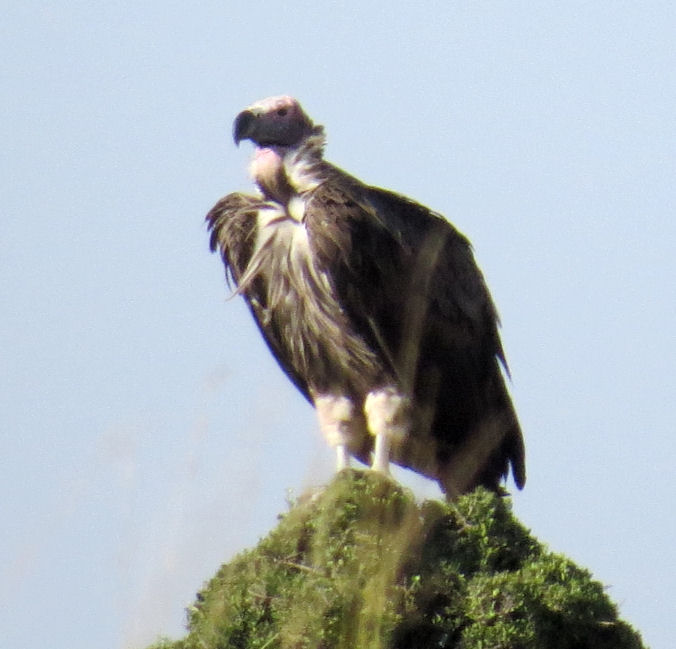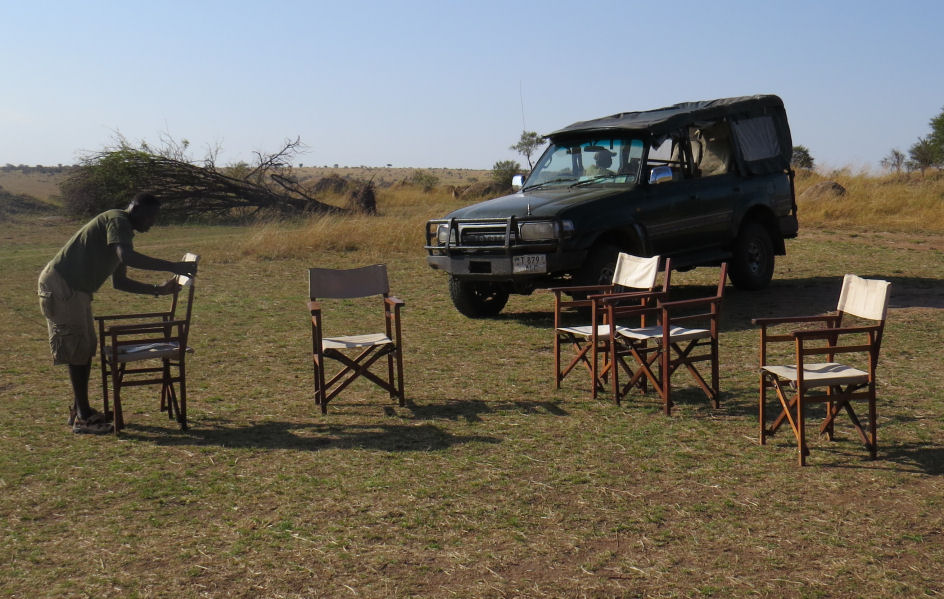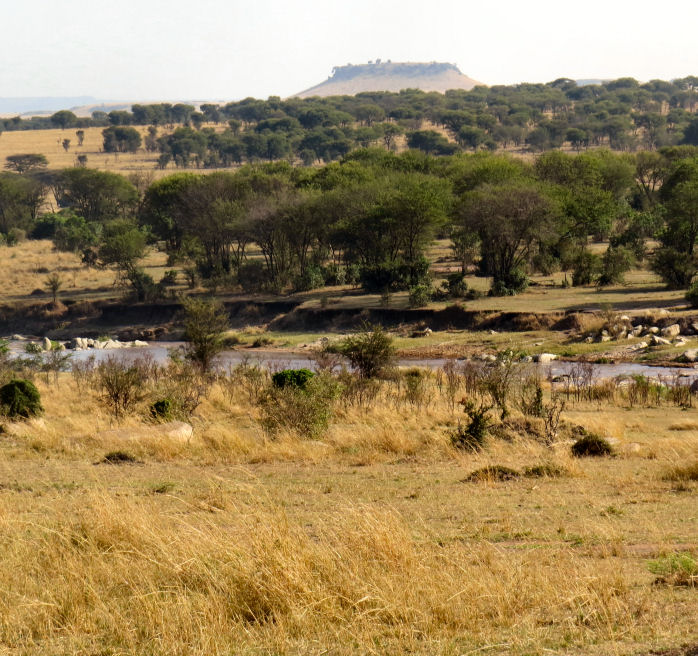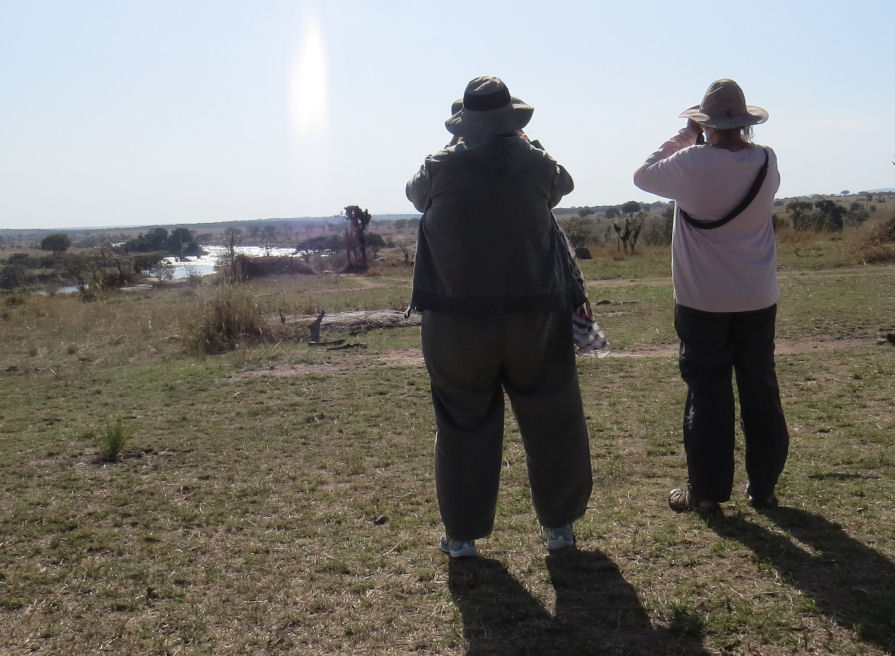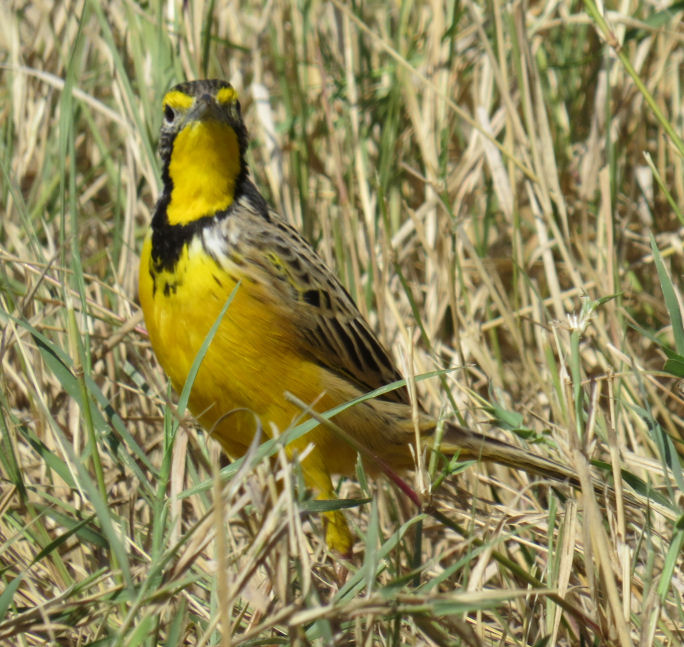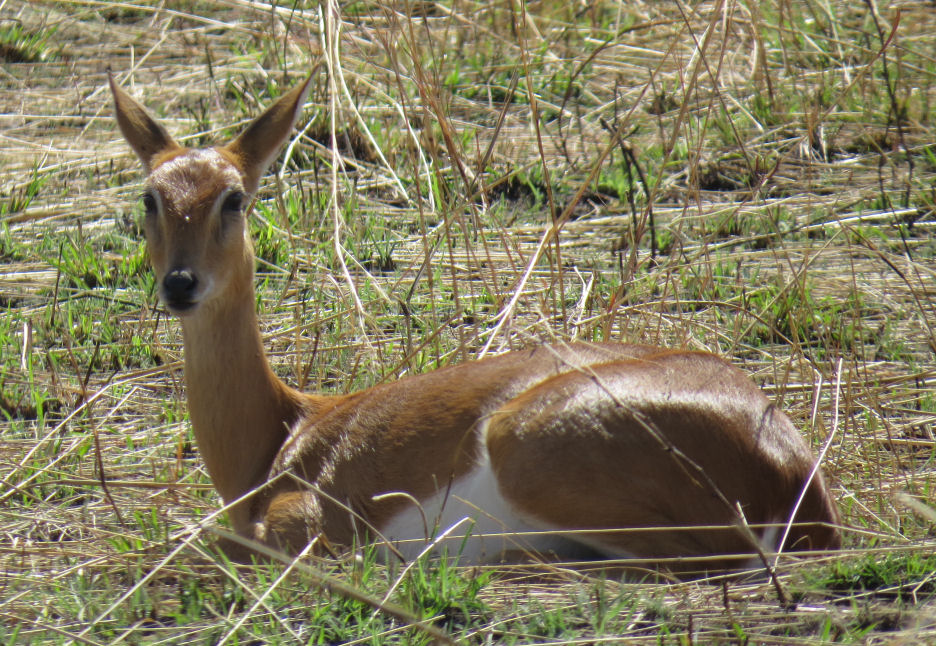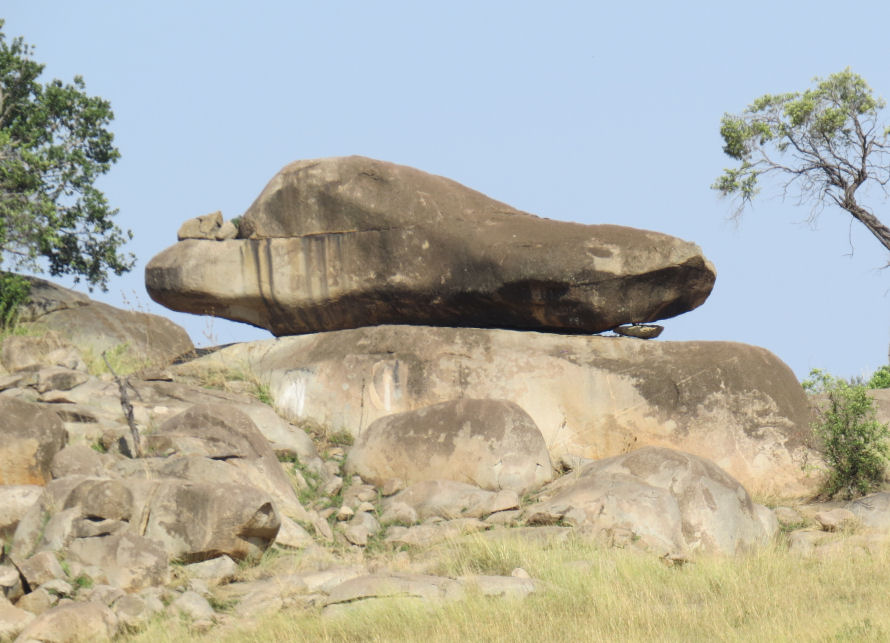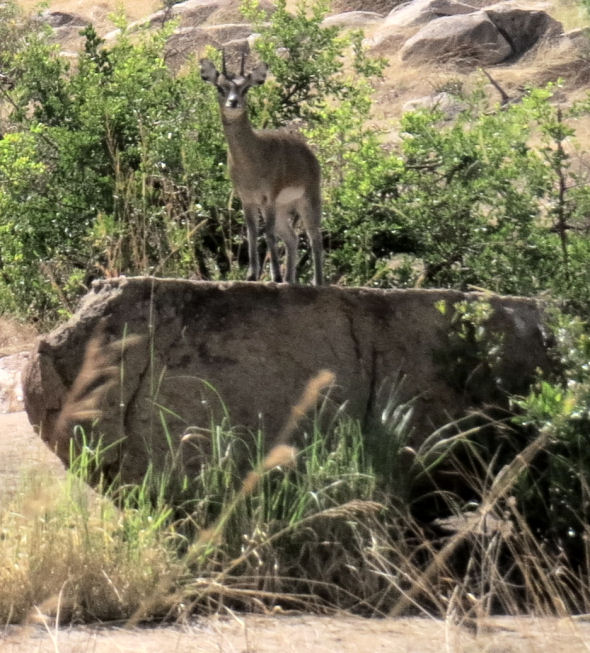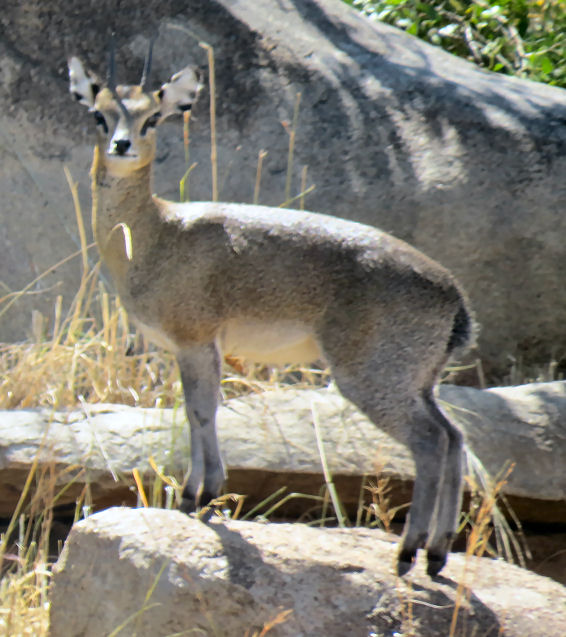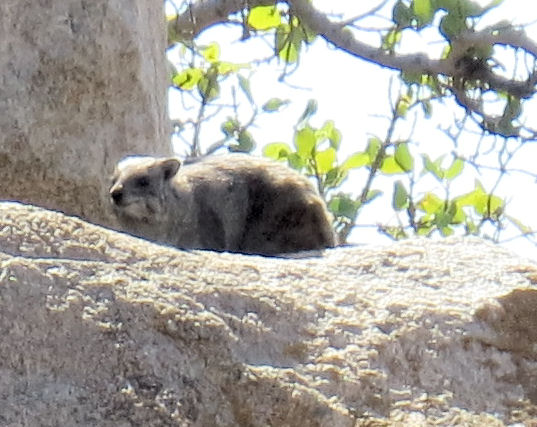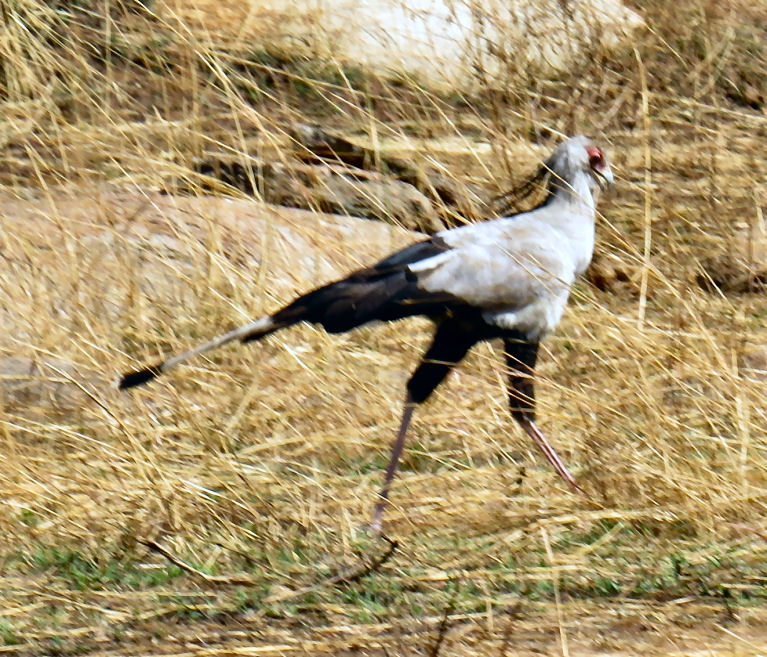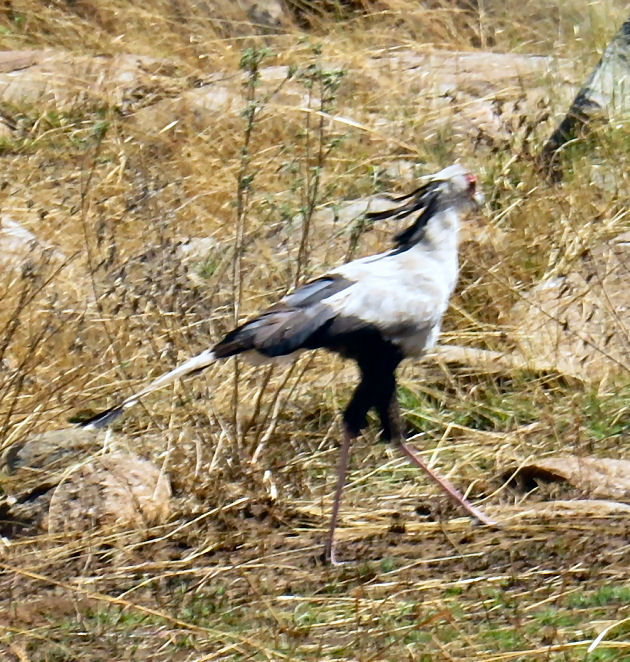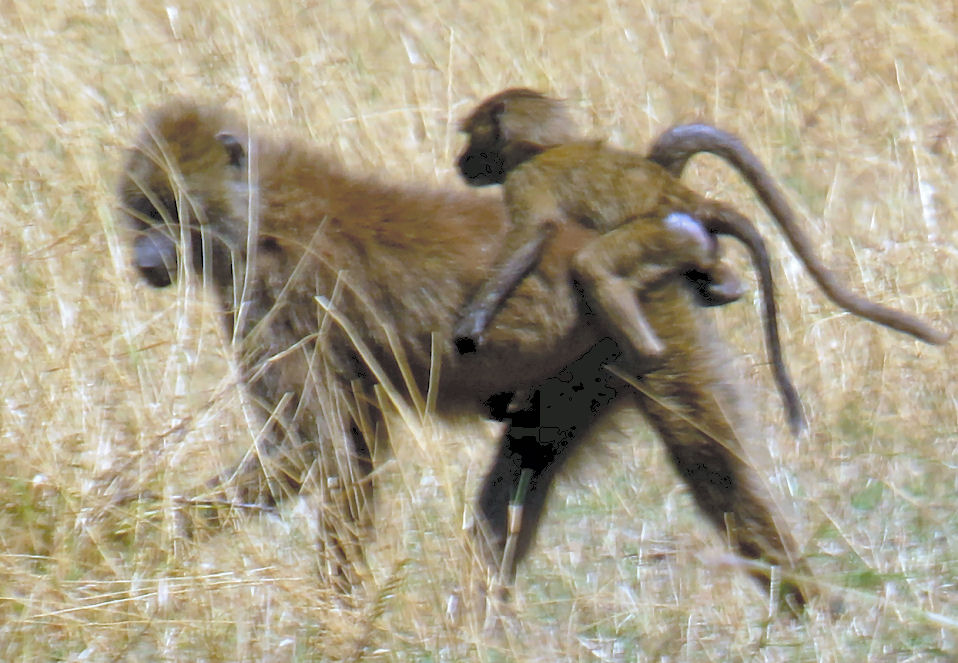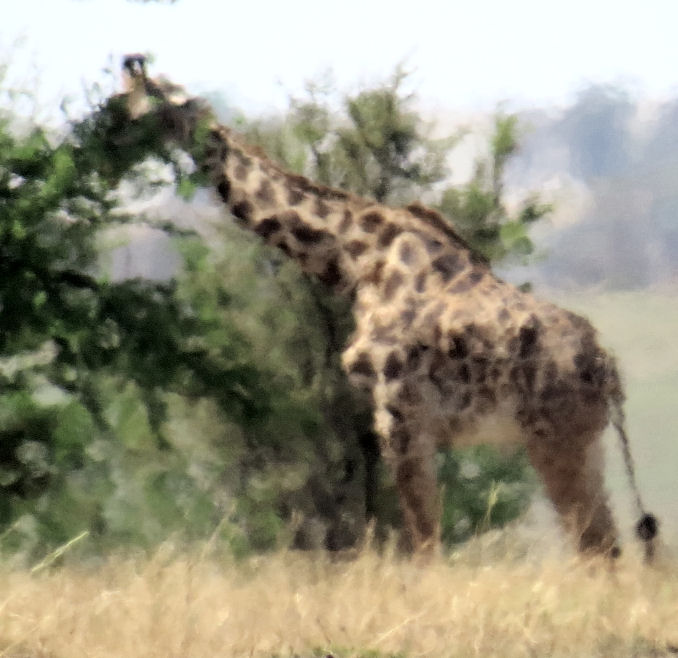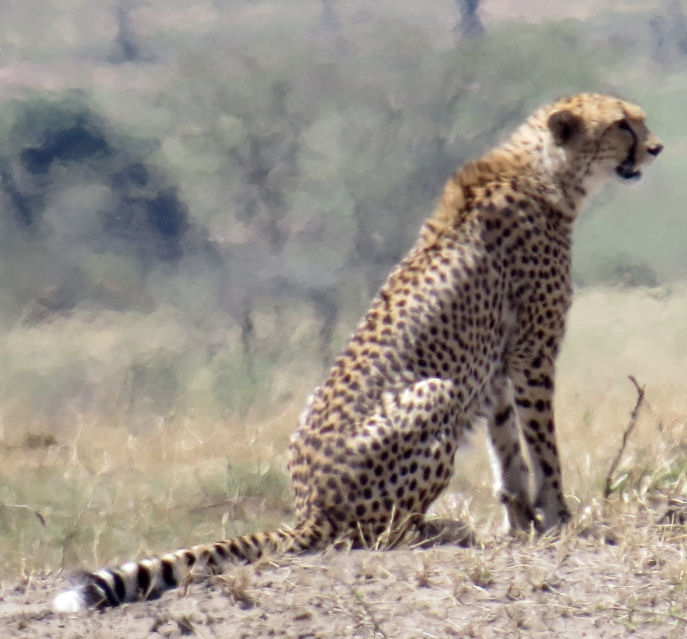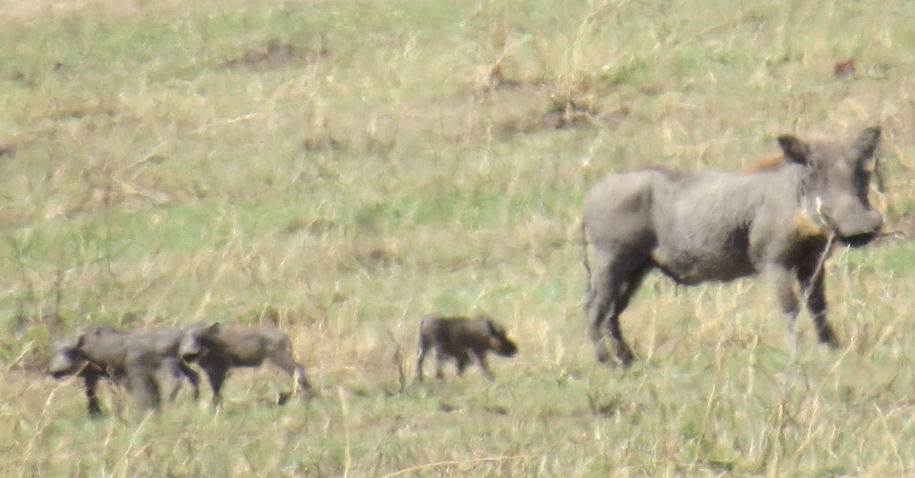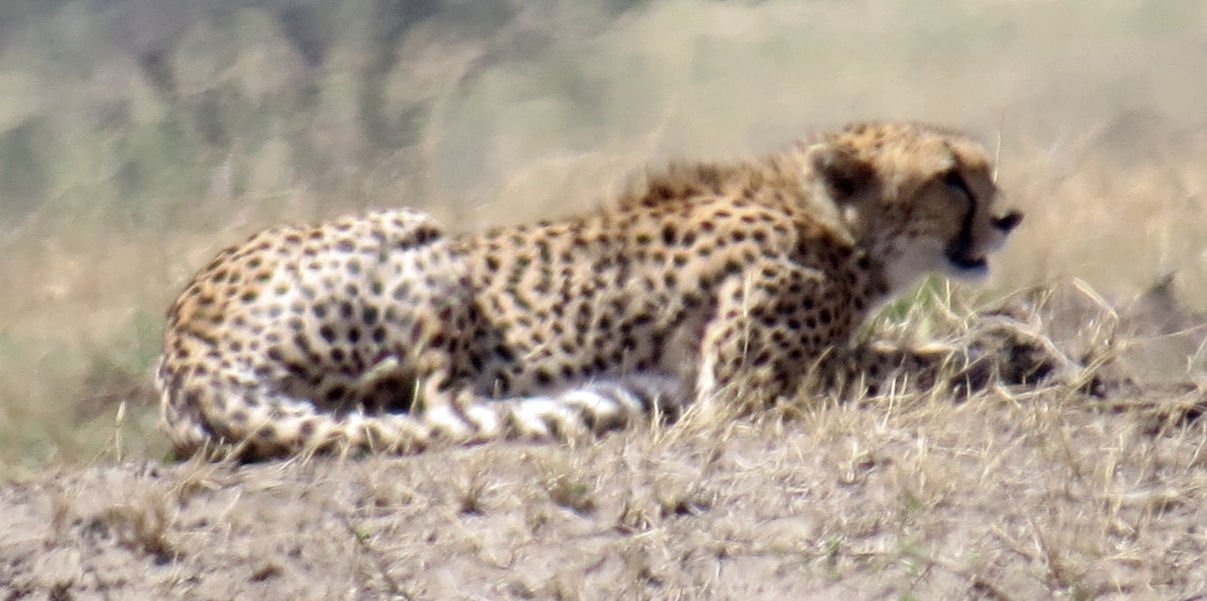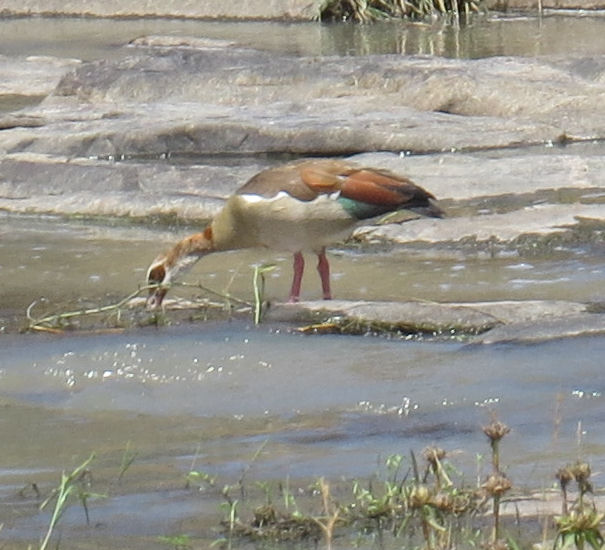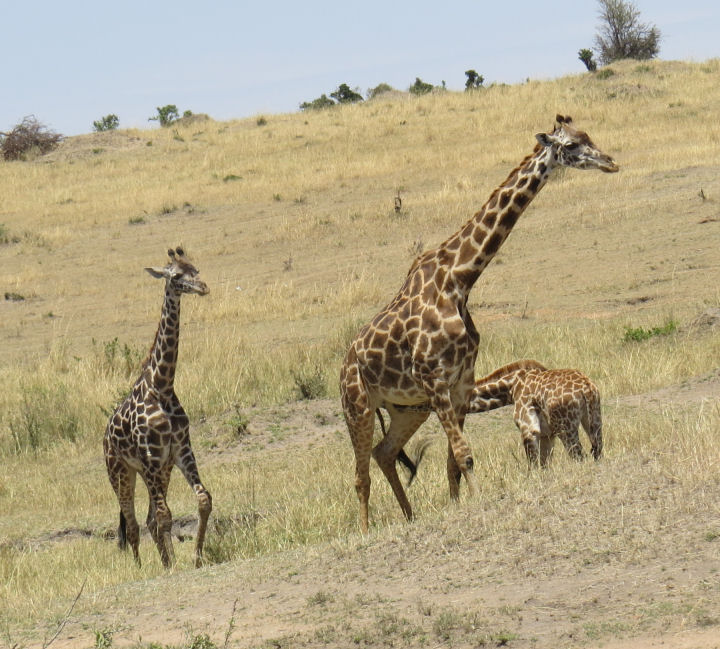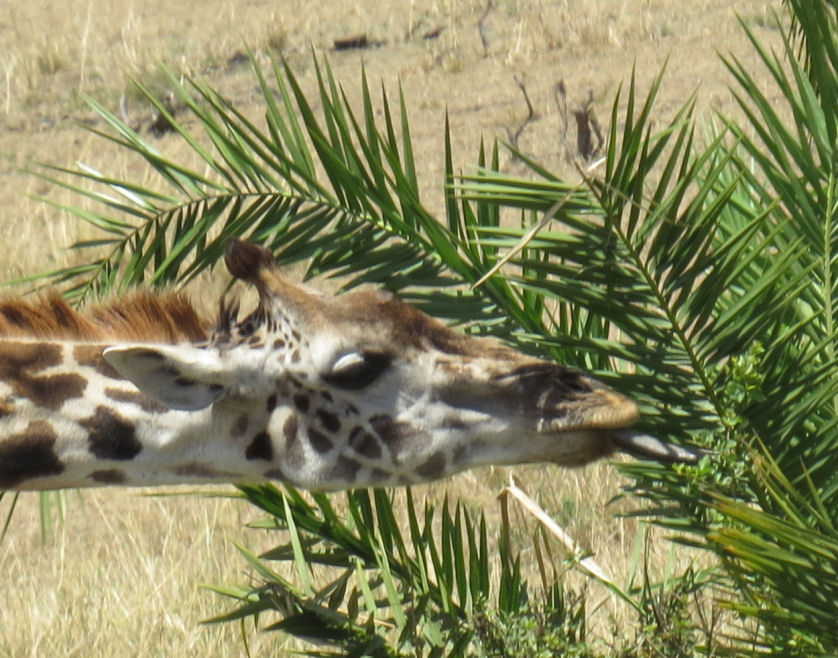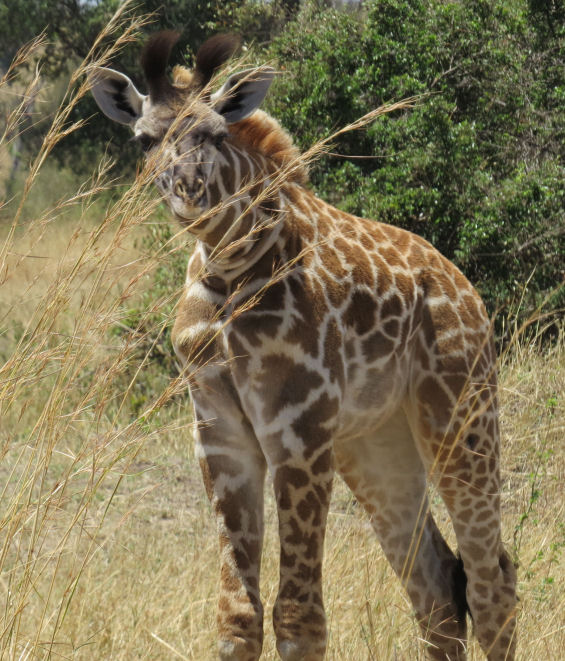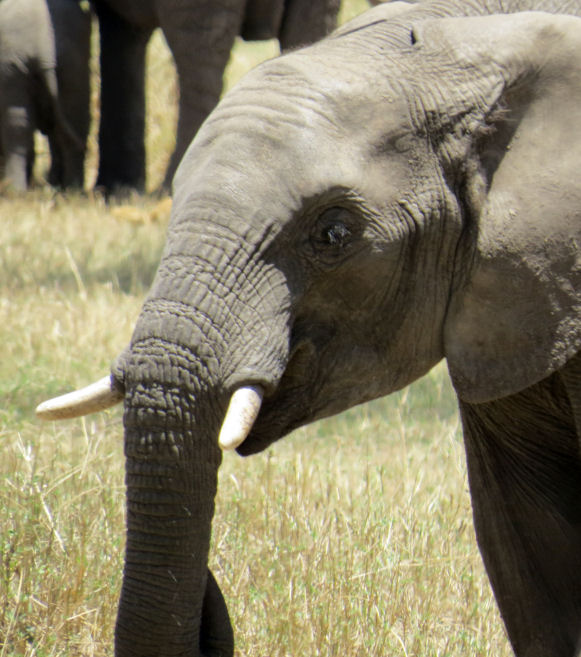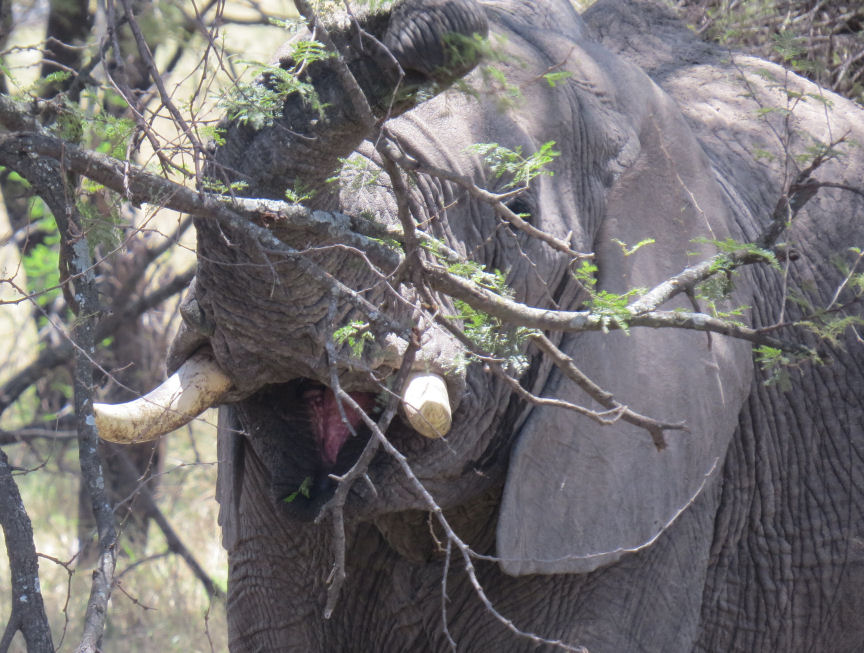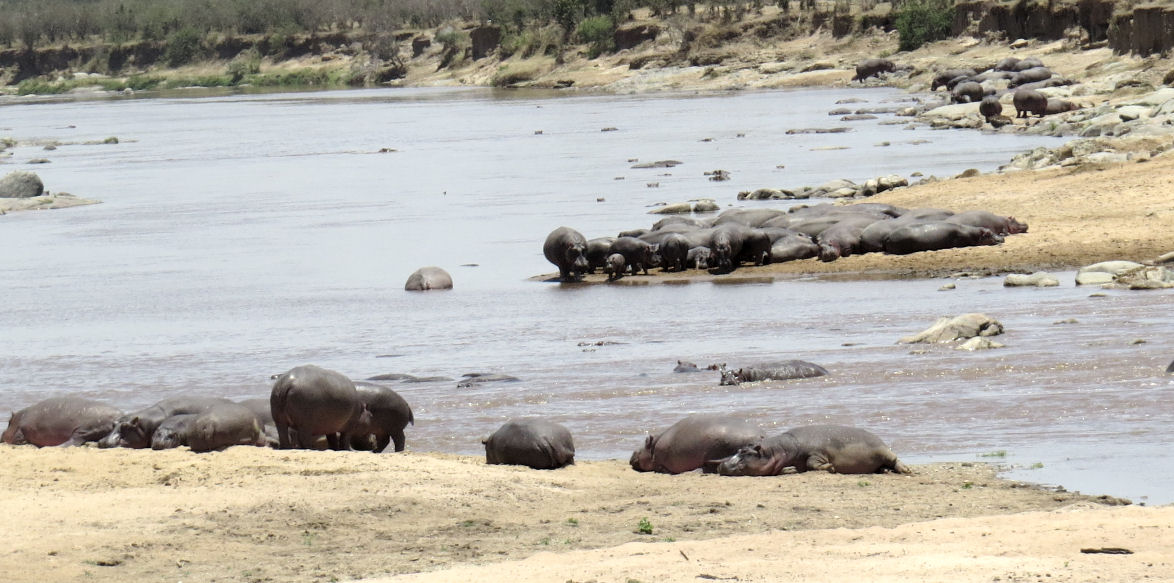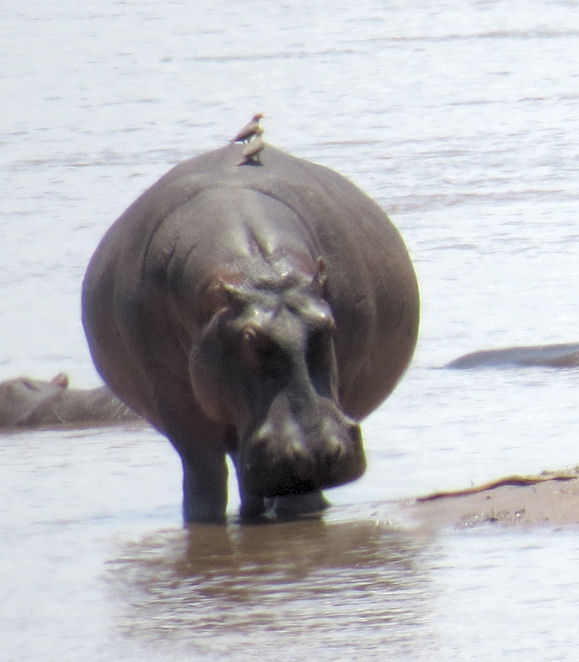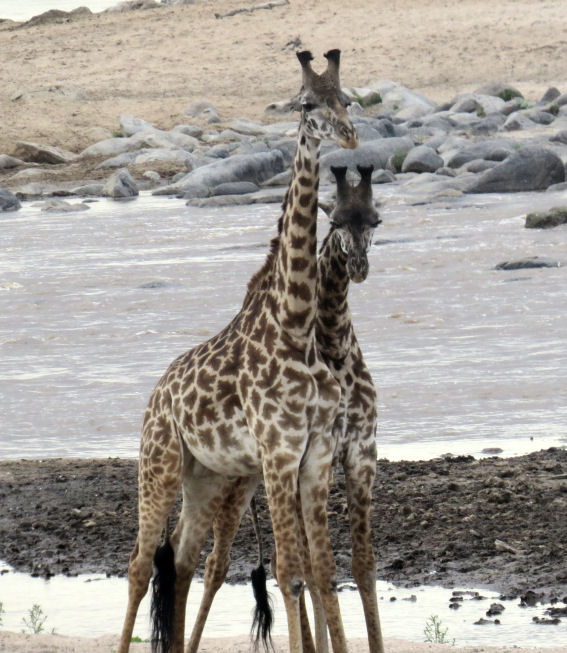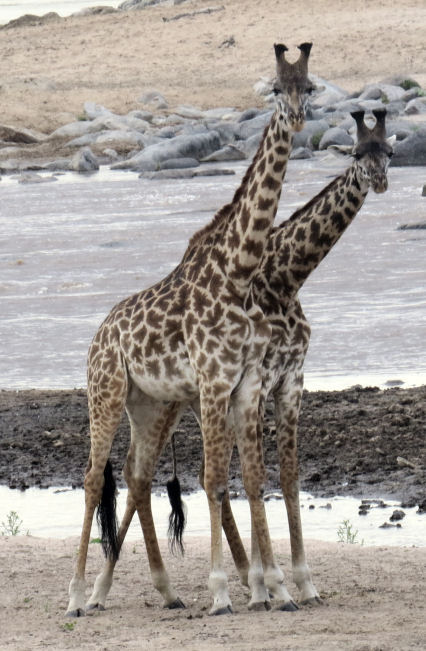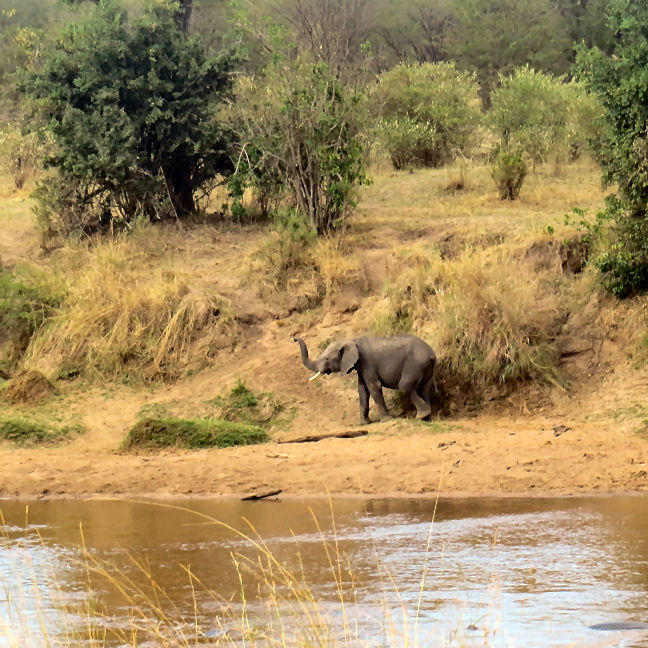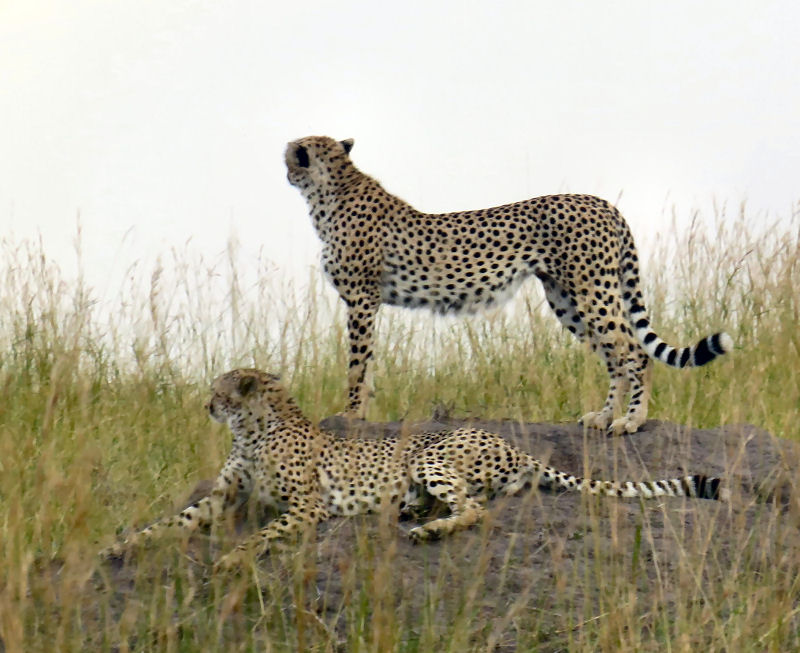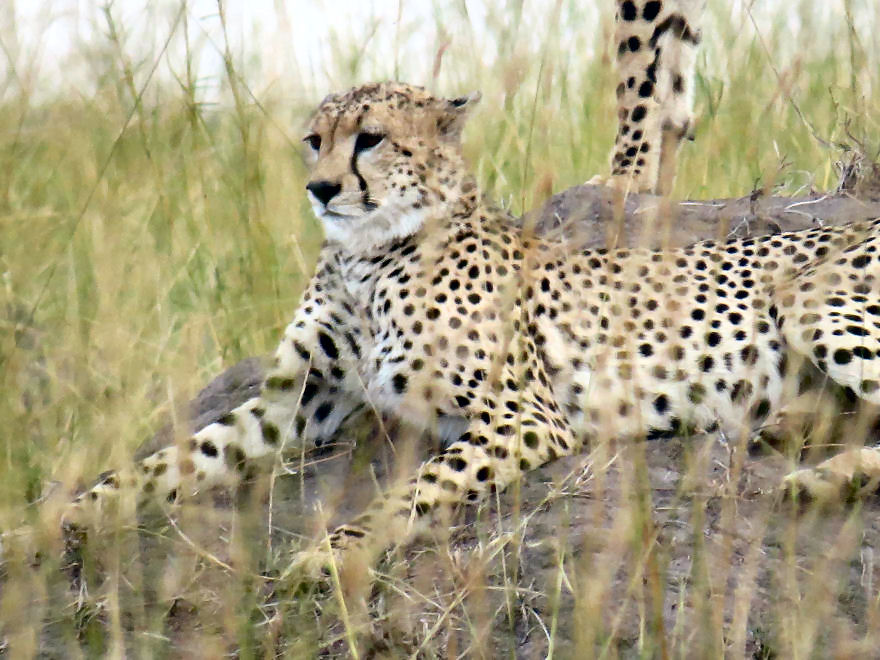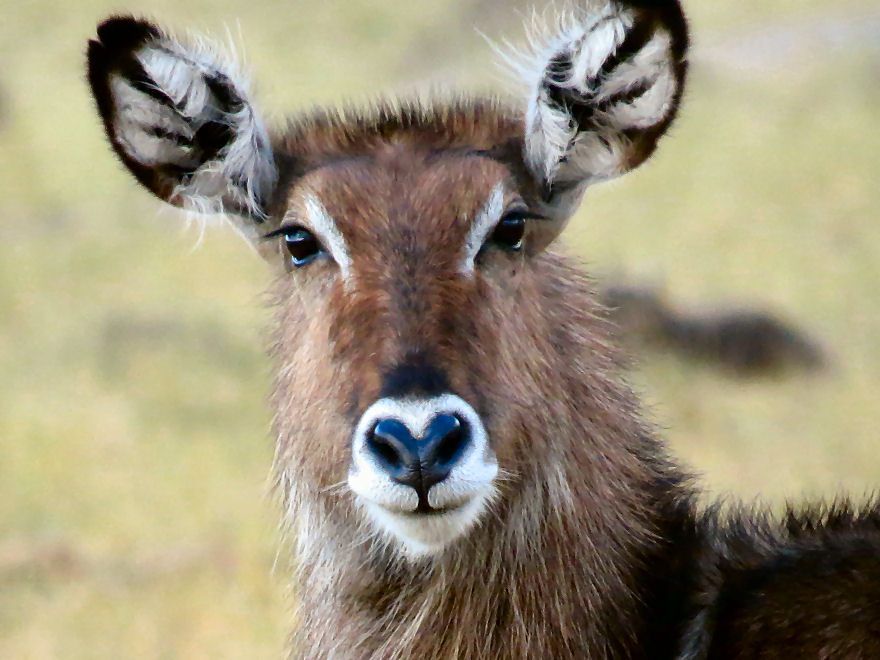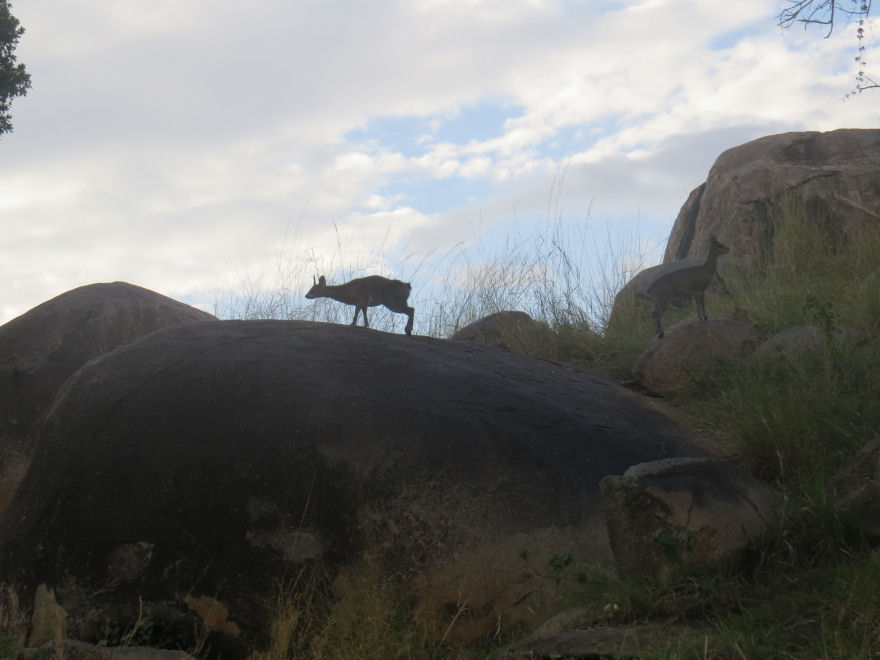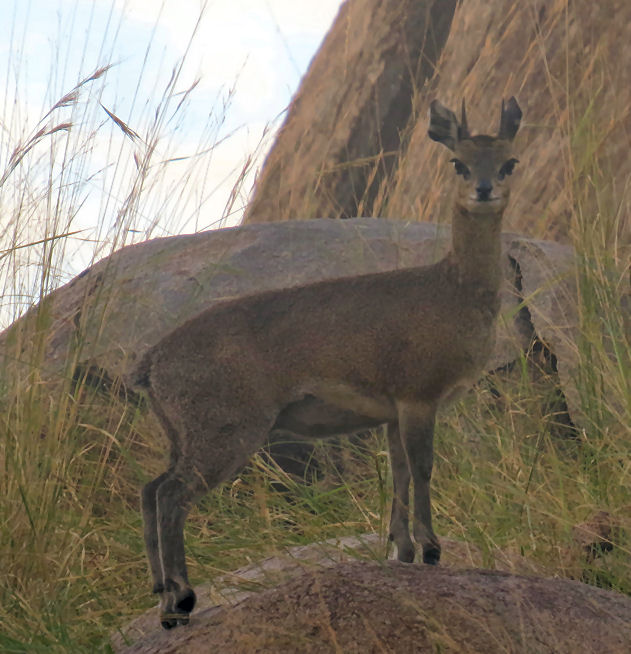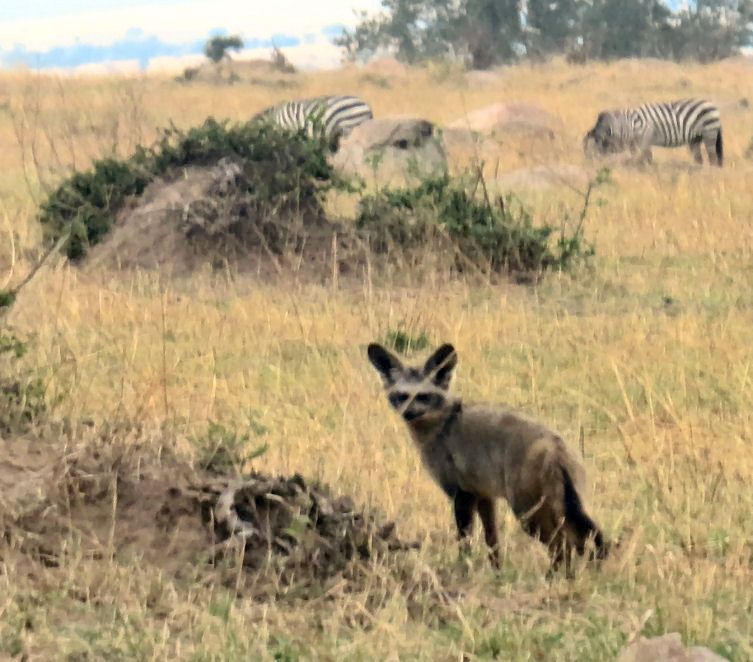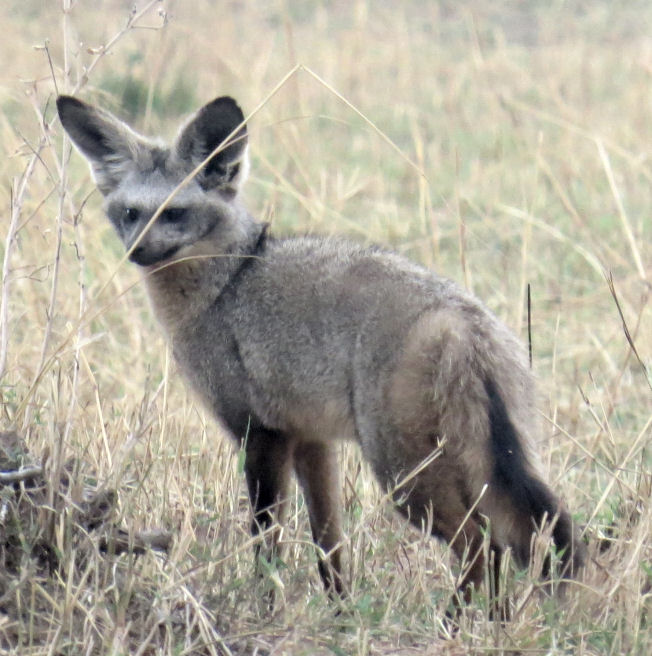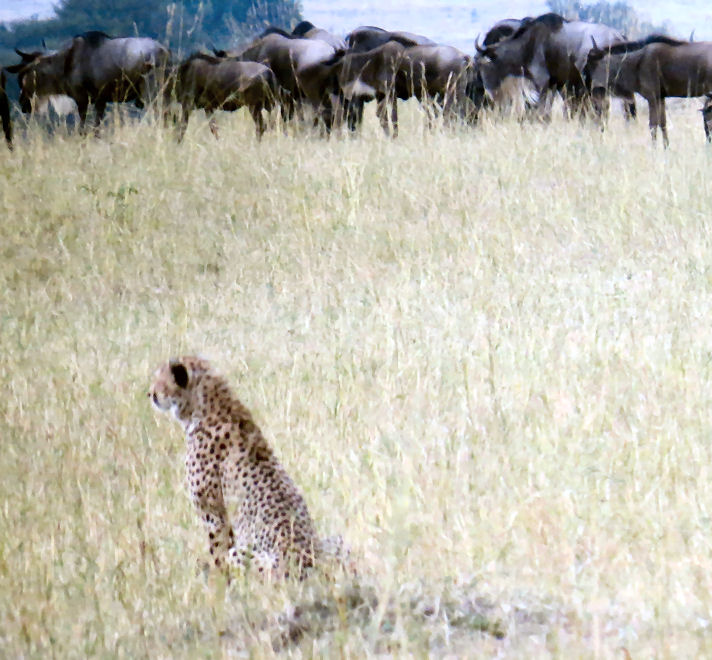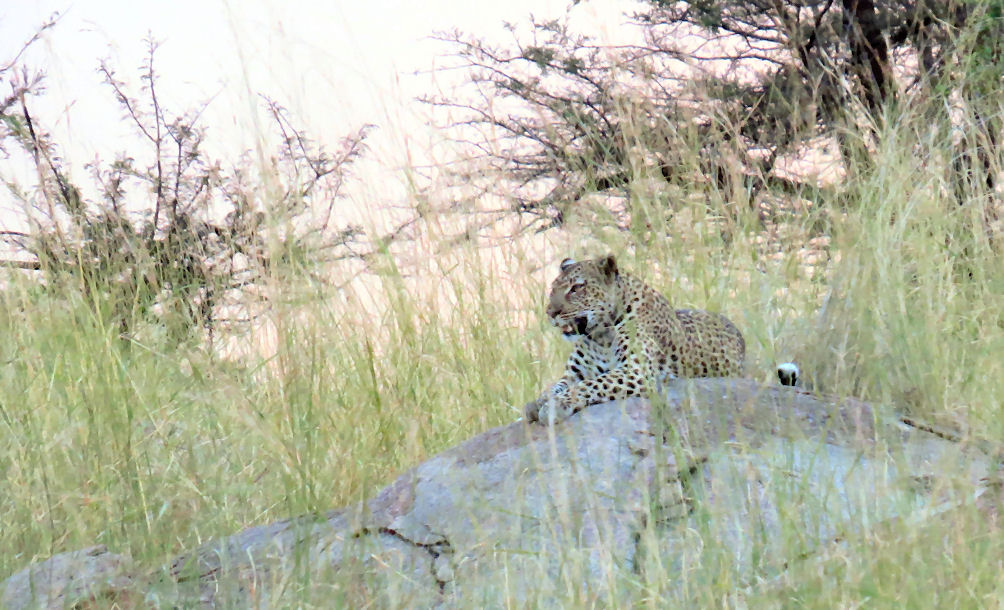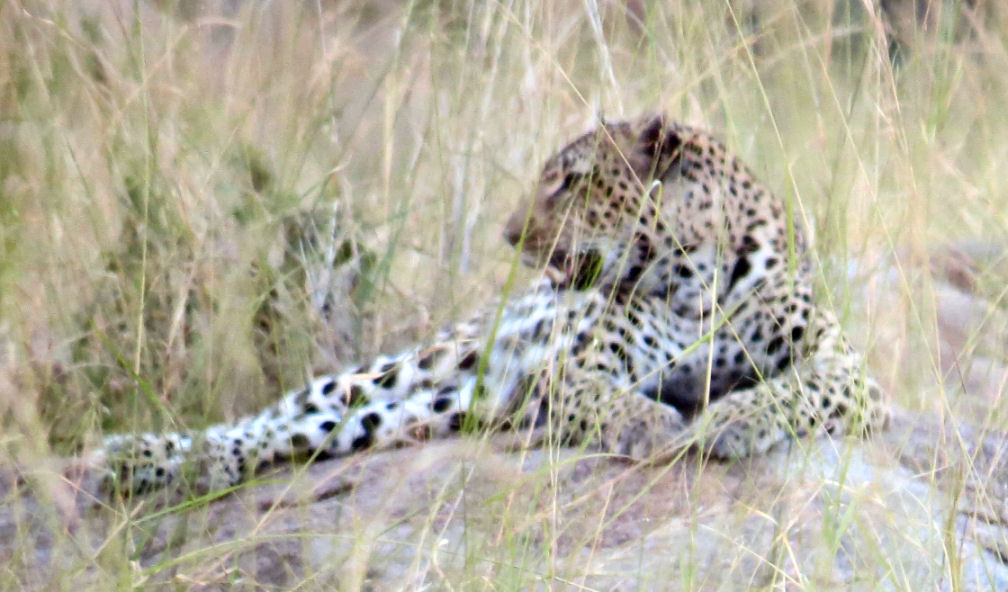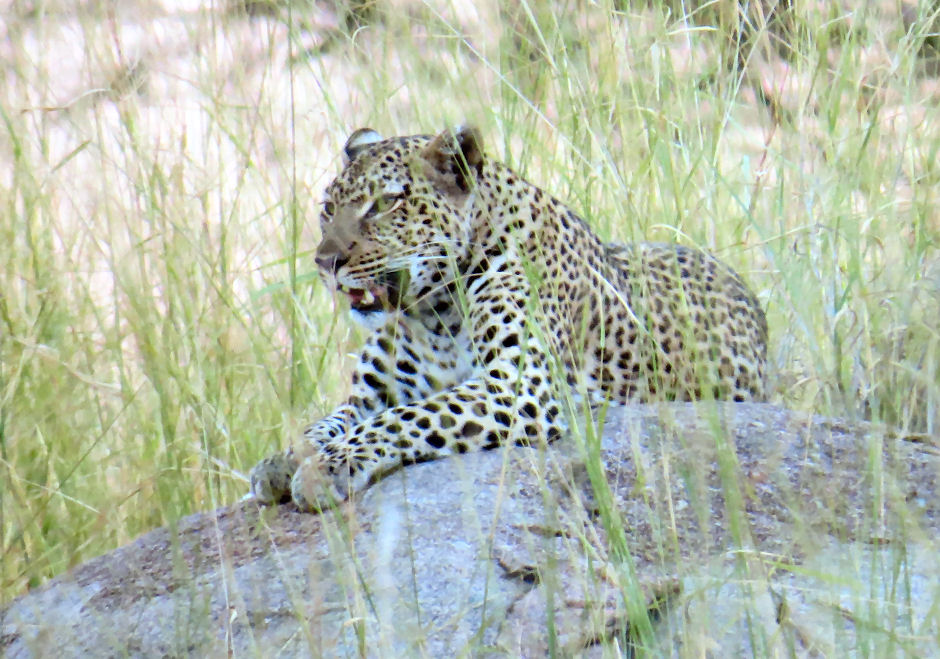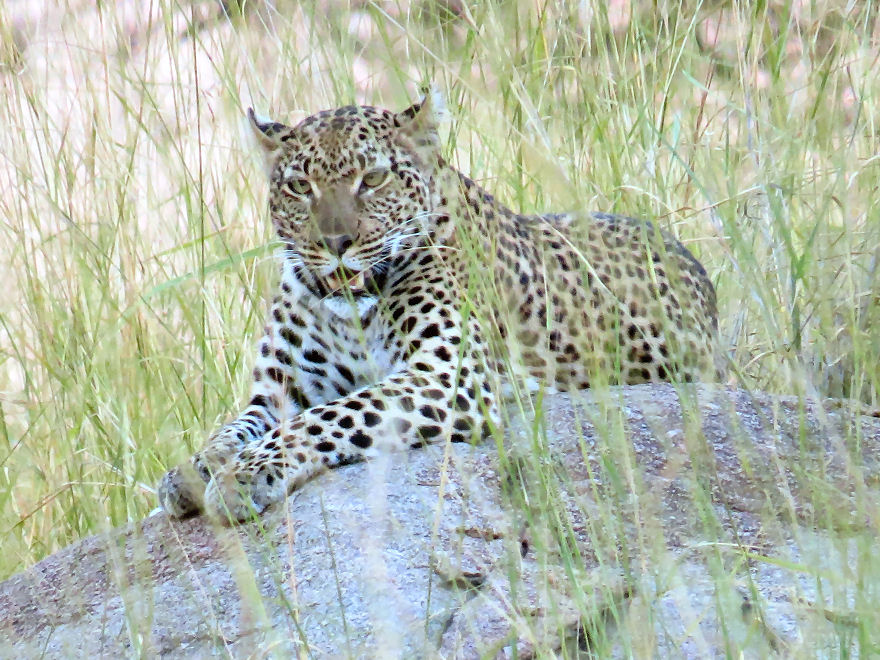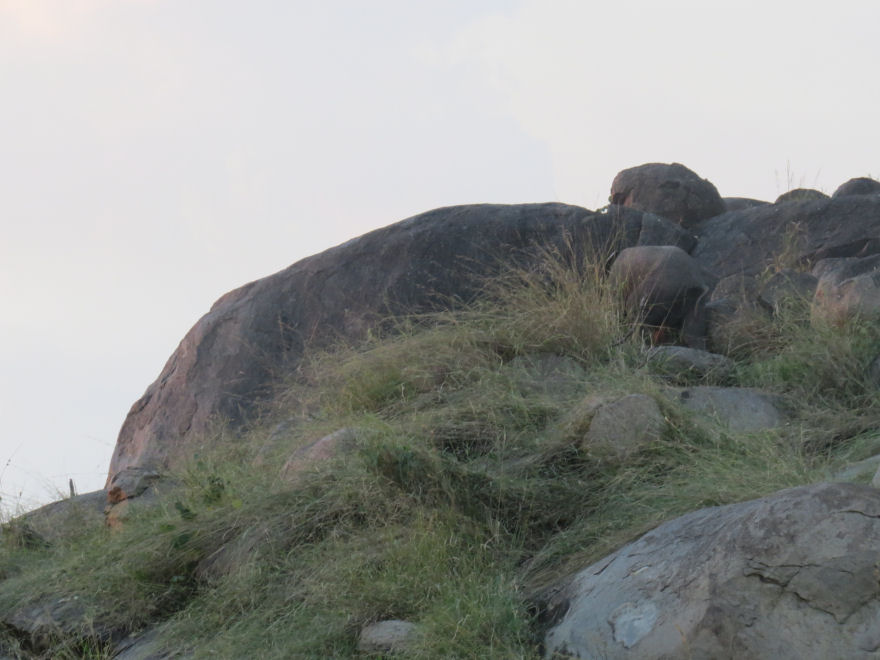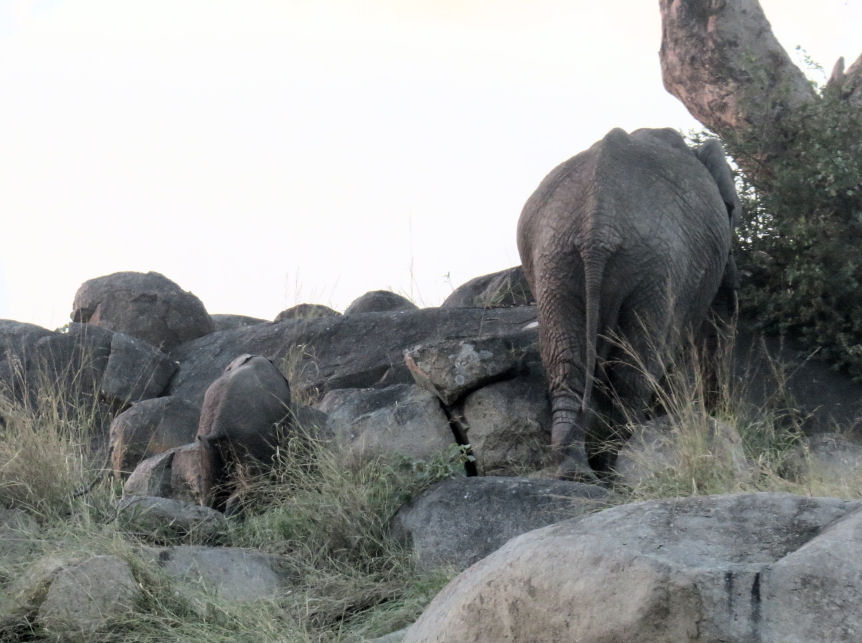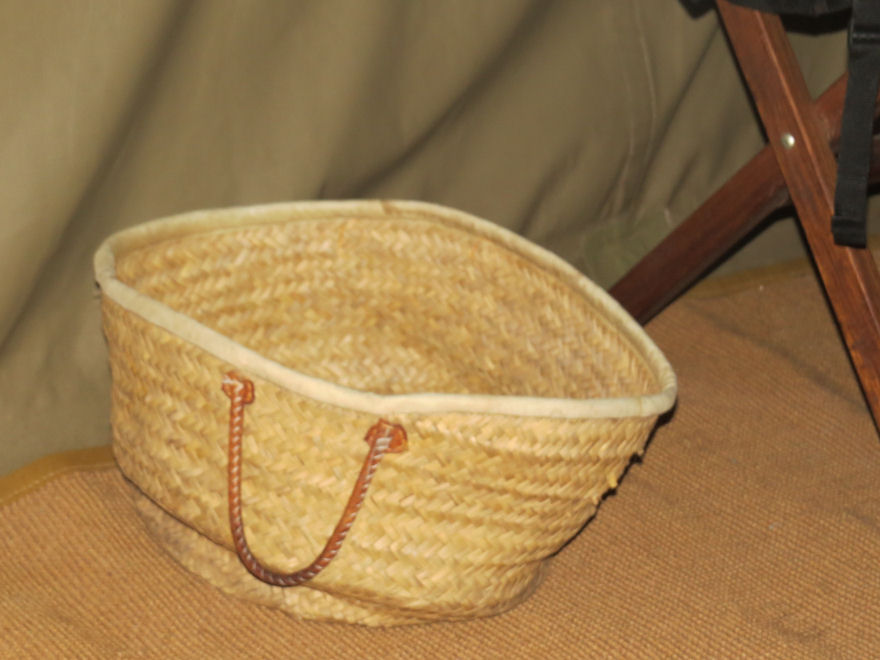
I felt pretty good when I woke up, but I was somewhat worried about the upcoming bush breakfast. The idea of addressing my digestive problems in the middle of the savannas where there were almost no trees, not to mention toilets, was a bit daunting. I still felt a little woozy and therefore decided to go easy on breakfast in hopes of postponing any reaction until we got back. I also took a Cipro pill.
Tanzania is so close to the equator that the sun rises there at approximately the same time all year. We all clambered into the vehicle at about 8. Everyone wore jackets, but on one expected to need them long. Sue took the front seat next to Baraka. Waili moved to the back seat, which was a few feet higher. When Waili spotted something, he told Baraka in Swahili in a low voice. Baraka must have had his internal audio receiver set to Waili's frequency. He always heard what Waili said and reacted immediately. For some reason they made me think of the Navajo code talkers in World War II.
I volunteered to sit in the middle of the back seat. I was hoping to amass brownie points that I could later redeem for sympathy if I embarrassed myself again.
Betty, as usual, was wound up. Before we even left the camp she announced that she wanted to see a secretarybird. Baraka said, "Oh, I saw one yesterday." Betty replied, "You what?" Hakuna matata, Betty, we would definitely see our quota of secretarybirds before we left the Serengeti.
In the dim light of Friday morning the first memorable moment came when we saw some ostriches scattered among a small herd of wildebeests. The birds were walking in one direction, the mammals in the other. The wildebeests generally ate only the green grass that was about an inch or less long. Ostriches seemed to be much less picky.
Almost immediately we came upon a group of three cheetahs that were on the move in the direction of a large group of wildebeests. They definitely appeared to be in the hunting mood, but whether they had the skill to pull off a successful kill seemed dubious. We stayed and watched them in hopes of seeing something exciting. I managed to get a few photos, but the world's fastest land animal (and one of the best camouflaged ones, as well) is not easy to photograph when it is on the move.
Someone asked the Swahili word for cheetah; Baraka told us that it was "duma," the same as the bogus Russian parliament. Baraka correctly concluded that these cheetahs were unlikely to do anything too memorable, and we moved on.
This encounter helped me to understand the cheetahs' big problem. They are faster than any prey, but, being much weaker than lions or leopards,[1] they must find a target that they can actually take down and a location that favors their straight-line speed.
A hot-air balloon rose slowly but steadily on the horizon. I remembered that Michael Palin on his Pole to Pole show had declared his disappointment with the experience of riding in one. The balloons did provide cool photo opportunities for early-bird tourists, however.
We saw some wildebeests running in the distance. When they think that they need to, these ungainly ungulates can really run. I am not sure whether they were fleeing the cheetahs.
Almost immediately after we left the cheetahs behind, we came upon a very photogenic lion perched on a rock surveying the landscape. Every lion that we had previously seen had been asleep or at least very drowsy.
We got to view some wildebeests crossing a creek. No, that did not count as a crossing.
Our attention was then drawn to the barking of a zebra. Baraka explained that it was the call of the male zebra to his harem, ordering them to join him.
We came across a very smelly carcass attended warily by two jackals, some marabou storks, and three types of vultures. Every so often one of the scavengers would spot an opening and swoop in to get breakfast. Half of the time these measures would result in short impromptu battles. With so many scavengers around, none of them could afford to spend much time and energy fighting.
Tom suggested that Baraka "Put our bush breakfast out in the middle of a field and let us fight for it." Tom is big and strong. In my day I was rather quick and wily. Now I am just old. In a scavenging battle, I would rely on the pity of others.
Baraka explained the origin of the huge rocks that dot certain areas of the Serengeti landscape. They are called Kopjes, and they reportedly were blasted to this location from one of the eruptions of Ngorongoro.[2] We saw a cinnamon-breasted bunting. It was all puffed up and reminded us of an American robin.
Baraka identified two birds for us, a lappet-faced vulture at the top of a tree and then, down on the ground, a Temminck's courser, just before we stopped for our bush breakfast. We came across several of the vultures and at least one of the latter after we resumed the game drive.
Another vehicle from the camp was already at the picnic sight when we arrived. It was equipped with our breakfast, five folding chairs, and a table on which to place the food. They did not skimp on the breakfast spread. There were eggs that seemed to consist entirely of whites, sausage rolls, buns, bread, coffee, and pineapple-mango juice in boxes. I tried a sausage roll, some bread, a little coffee, and the juice. I felt pretty good even with the food in my stomach. I was beginning to think that my problems might be over or at least abetting.
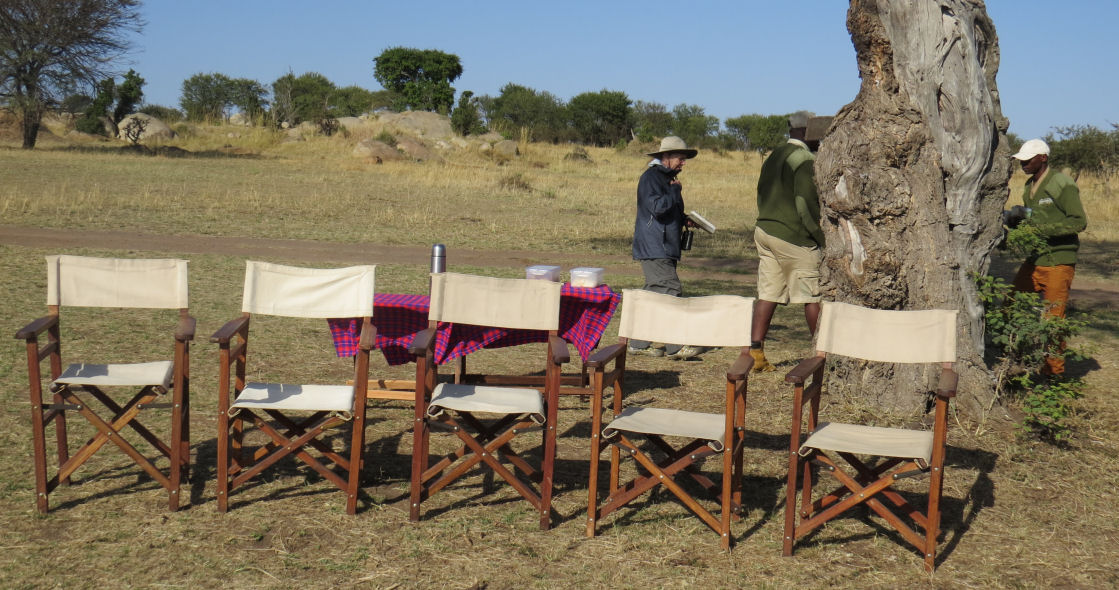
During the breakfast break someone discovered some lion scat on the ground, but its depositor was, thankfully, long gone. By some rocks we saw some buffaloes on the move.
A rufous-naped lark was discovered in a tire rut, and a yellow-throated longclaw also was spotted. I failed to snap a photo of the lark, but I got several nice ones of the longclaw. We also saw an oribi, which is an antelope.
We drove near some of the kopje rocks and discovered a few graceful klipspringers, which are tiny antelopes that hang out around the rocks. Unless my eyes deceived me they actually walked on the very tips of their hooves.
We also saw a rock hyrax. I was fairly certain that it was completely motionless, but my photos showed that it had moved a little. So, I guess that really was a rock hyrax and not a hyrax-shaped rock.
At long last Betty got to see her secretarybird. It was on the move at a rapid pace looking and listening for insects or other small creatures, and we followed it for at least fifteen or twenty minutes. I took a large number of photos. Most of the time it was trotting away from us at a pretty good clip, but a few of my shots were presentable.
Baraka told us about a symbiotic relationship that baboons have with some other animal. I neglected to record the species of the other participant.[3]
We then came upon a very strange scene perhaps forty yards away. A cheetah sat there, peaceful but alert. About forty yards from the cheetah on one side was a giraffe, as always munching on leaves. About the same distance away on the other side a warthog and three small piglets seemed oblivious of any threat. Eventually ten cars were gathered to watch this scene, but the cheetah made only a few non-threatening moves. Baraka got disgusted and left the scene. "Ten cars for one cheetah; it's ridiculous," he muttered.
We saw a large female crocodile a fairly long way from the nearest water. Baraka speculated that she might be protecting her eggs.
At some point Baraka and Waili unrolled part of the canvas used as a roof for the vehicle in order to shield Sue from the sun. By then everyone in the New England group had doffed his/her jacket.
We saw a little egret, a zebra carcass, and some elephant bones.
We watched a group of giraffes walking and consuming leaves. I decided to concentrate on trying to get a shot of the famous purple tongue.
A tawny eagle soared overhead. I missed it.
We spotted a group of fifteen elephants in the trees off to our right. For a few minutes we watched them tear apart some of the more accessible trees. No one should need to work so hard for breakfast.
We then beheld a huge congregation of hippos in or near the water. Betty estimated that there must have been at least seventy-five of them. A group of hippos is either a "bloat" or a "thunder." These were too quiet to be considered a thunder.
Baraka drove us back to camp for lunch. I was beginning to gain confidence that I had turned the corner on my condition. I did not hold back at lunch. I did not record what I ate, but it was substantial.
After lunch I took photos of our tent, inside and out. I spent the rest of our off-time lounging, napping, and reading.
We had hardly left camp at a little after 4:00 when we felt a few drops of rain. The skies looked threatening enough that Baraka stopped the vehicle. He and Waili unrolled the canvas top and fastened it so that all three seats were shielded from the rain. As it turned out, the shower was short, but the clouds persisted throughout the afternoon. At least Sue was spared the equatorial sun, which she found intolerable.
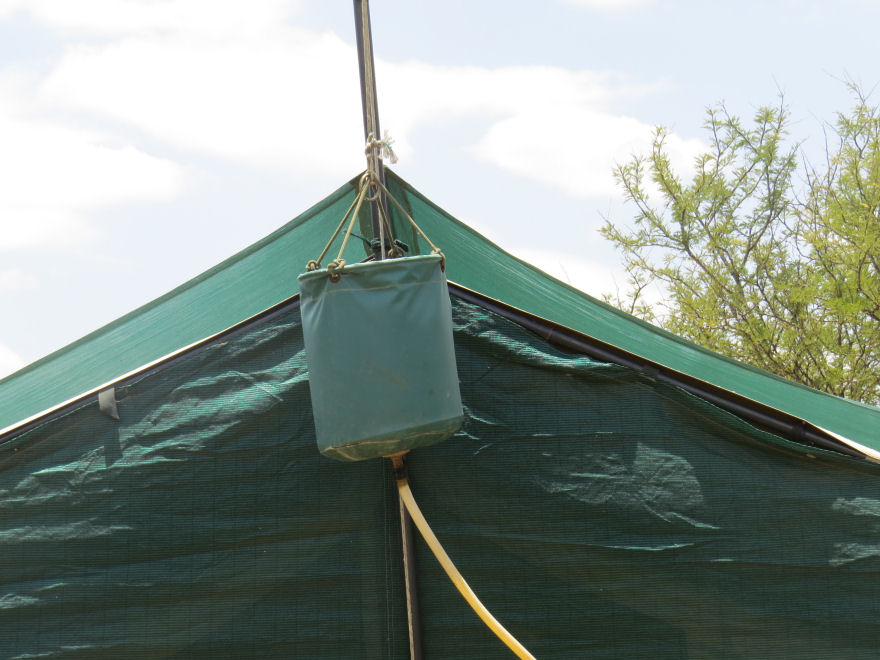
Throughout the four days of our stay in the Serengeti wildebeests would continually wander into the road before us. When they realized their peril, they would commence sprinting in whatever direction they happened to be headed at the time. Only after reaching a high speed would they consider swerving. All of the other animals nonchalantly moved to one side of the other when we they saw us coming. Only the wildebeests panicked in this bizarre manner.
Baraka informed us that a few weeks earlier a wildebeest sprinted out on the runway in Kogatende in front of an airplane. Suffice it to say that blood got all over the plane.
We watched a pair of giraffes engage in strange behavior. They stood hip to hip facing one another, in which position they took turns flinging their heads slowly in front of one another.
Baraka said that they were males who were most likely brothers. They were probably practicing their fighting moves. The giraffes' preferred weapon in encounters with other giraffes is the headbutt.[4]
We spent most of the afternoon in one of the rocky areas of the park. On the way there we saw a hamerkop, a bird famed for the extremely large nest that it builds.
We came across a group of elephants near some more hippos. These two heavyweight species do not ordinarily congregate in the same place.
I have some advice for the park rangers. Please devote more time to training both of these huge beasts to stand on their front paws or perform some other tricks. We saw a large number of both of them, but during the day all the elephants did was eat, and the hippos just lay around or submerged themselves. We did hear some hippos grunting. I guess that might count for something.
My notes indicate that we viewed some more rock hyraxes, but I was unable to take any photos of them. Therefore, I cannot verify that they were not actually hyrax rocks.
For several minutes we watched two cheetahs that had definitely attracted the attention of some nearby zebras. When the zebras spotted a dangerous predator, they froze until they had determined whether they were in imminent danger. The cheetahs were followed by some jackals that presumably hoped to steal all or part of the kill. They probably overrated the hunting ability of these cats.
We spotted another waterbuck. Baraka told us that lions won't eat them because they are smelly. In point of fact the lion's diet is rather selective. I read somewhere that some researchers found the remains of only twelve different species in an extensive study of lion scat in the Serengeti. Leopards, on the other hand, feasted on thirty different species.[5]
Speaking of leopards, where were they? Betty continually pestered Baraka about showing us a leopard. She claimed that she was doing this on my behalf. It was true that I had expressed a fairly strong desire to see one, but I seriously doubted that my enthusiasm for leopards exceeded hers.
We next discovered a mixed group of impalas and zebras. That was slightly unusual. Overhead flew a grey kestrel, but I was unable to get a shot of it because the canvas roof was still on the Land Cruiser, and I was in the middle seat.
We saw two more klipspringers bounding around and posing dramatically on the rocks. We also spotted an oribi, another medium-sized antelope.
Someone spotted a jackal as we drove past what looked like a den. Baraka immediately slammed the car into reverse and slowly backed it up. He informed us that we had seen not a jackal, but a bat-eared fox, a much rarer find. Although they are rather numerous, the ones in Tanzania ordinarily leave their dens only at night.
The light was rapidly diminishing as we passed another giraffe. Baraka got a tip on his radio that impelled him to wheel the car around and speed back toward the kopjes. As he neared the destination, he slowed down dramatically, lowered his voice, and told us to get our cameras ready. He had never acted like this before.
For the next few minutes we were privileged to watch a leopard that had been resting all day and was getting ready, perhaps, for a night of hunting. This was pretty thrilling. Baraka seemed to be able to produce at will whatever species of animal that we requested.[6]
The next sighting was almost as dramatic. We watched a mother and baby elephant that had climbed up on the rocks. The elephants' drab grey coloring provides no camouflage on the savanna, but it certainly was effective here. They were almost indistinguishable from the large rocks.
When we arrived in the camp we were, as always, greeted by Belinda. Although this surely was a jejune occurrence for her, she showed great interest when we told her how Baraka had found a leopard for us at the last minute.
Sue and I then showered and got ready for supper. We were so late arriving at the campfire that we almost missed it.
I wrote down the word "supper" in my notebook, but I neglected to record any details. I do recall that I really like the soups that were always the first course. Waiters brought the soup course and all of the other dishes to each person at the table - female guests, then male guests, then staff. The main courses are all a blur to me. I seem to remember consuming quite a bit of broccoli.
The four Texans had evidently been replaced by three people, a couple and their son. I did not get a chance to talk with the newcomers on Friday.
After supper I copied my photos for the day from my camera's memory card to a flash drive. I had already taken over a thousand photos, and I had only had the camera for four days.
I then took a Cipro and a Malarone. I felt pretty good when I went to bed, but I was up several times during the night. I had been spending far too much time in the toilet on this trip. I had to content myself with the fact that it had not interrupted a game drive, at least not yet.
[1] Leopards are about the same size as cheetahs (77-143 pounds), but leopards are much more powerful. Lions are much more massive than the other two big African cats. Females average about 280 pound, and adult males can easily reach 800 pounds, equivalent to five or six leopards!
[2] This sounded a little strange to me. According to every source that I found on the Internet, the kopjes are actually metamorphic rocks that were pushed up ages ago and have been revealed when the soil (which was deposited by volcanoes) has sufficiently eroded.
[3] They definitely seem to have relationships with elephants, but I do not think that that was what Baraka referred to. The other animal might have been the impala. We saw them together.
[4] When I was a kid in Prairie Village, KS, I had two friends named Don and Steve Wood. They practiced fighting with each other, too, but they were a lot more violent than this pair.
